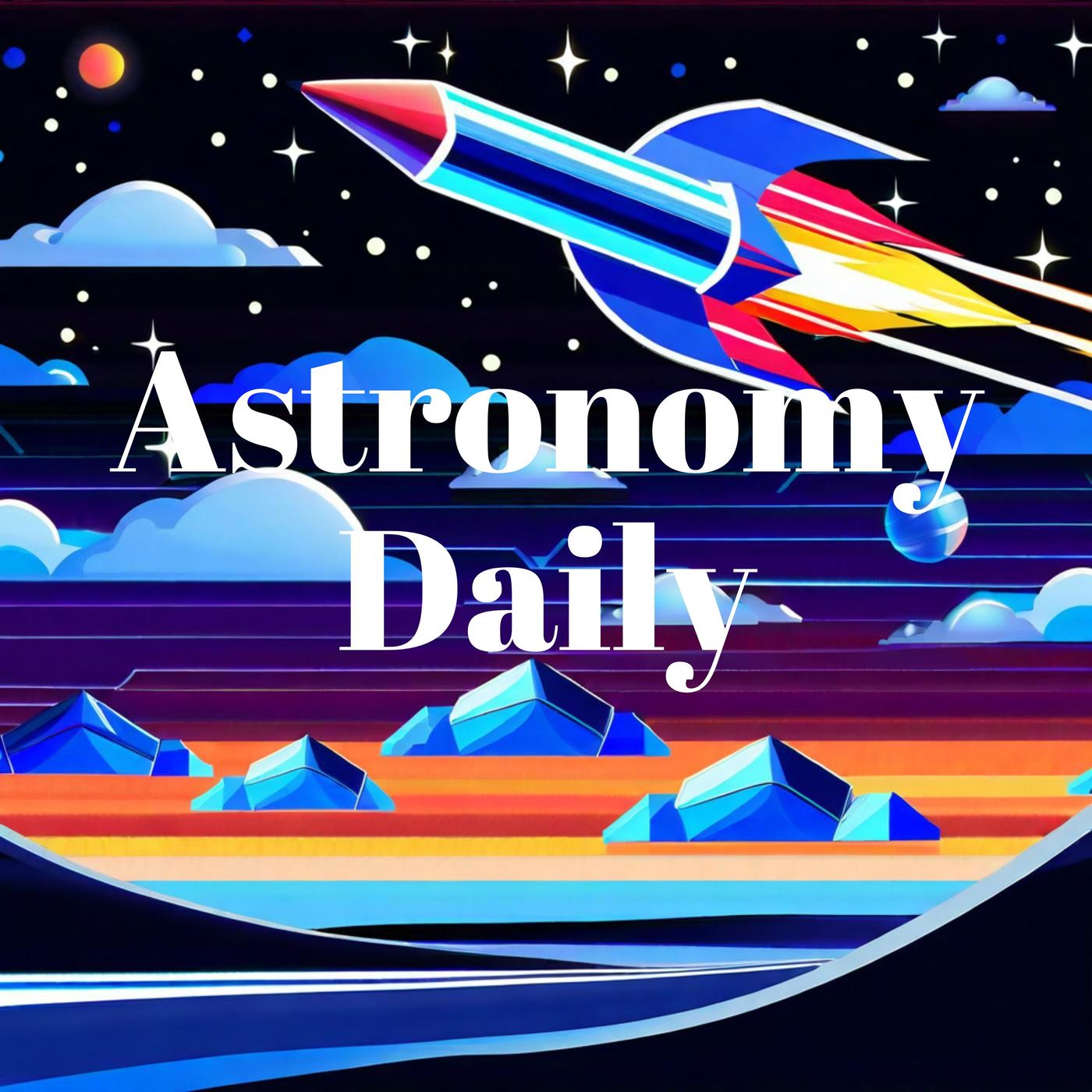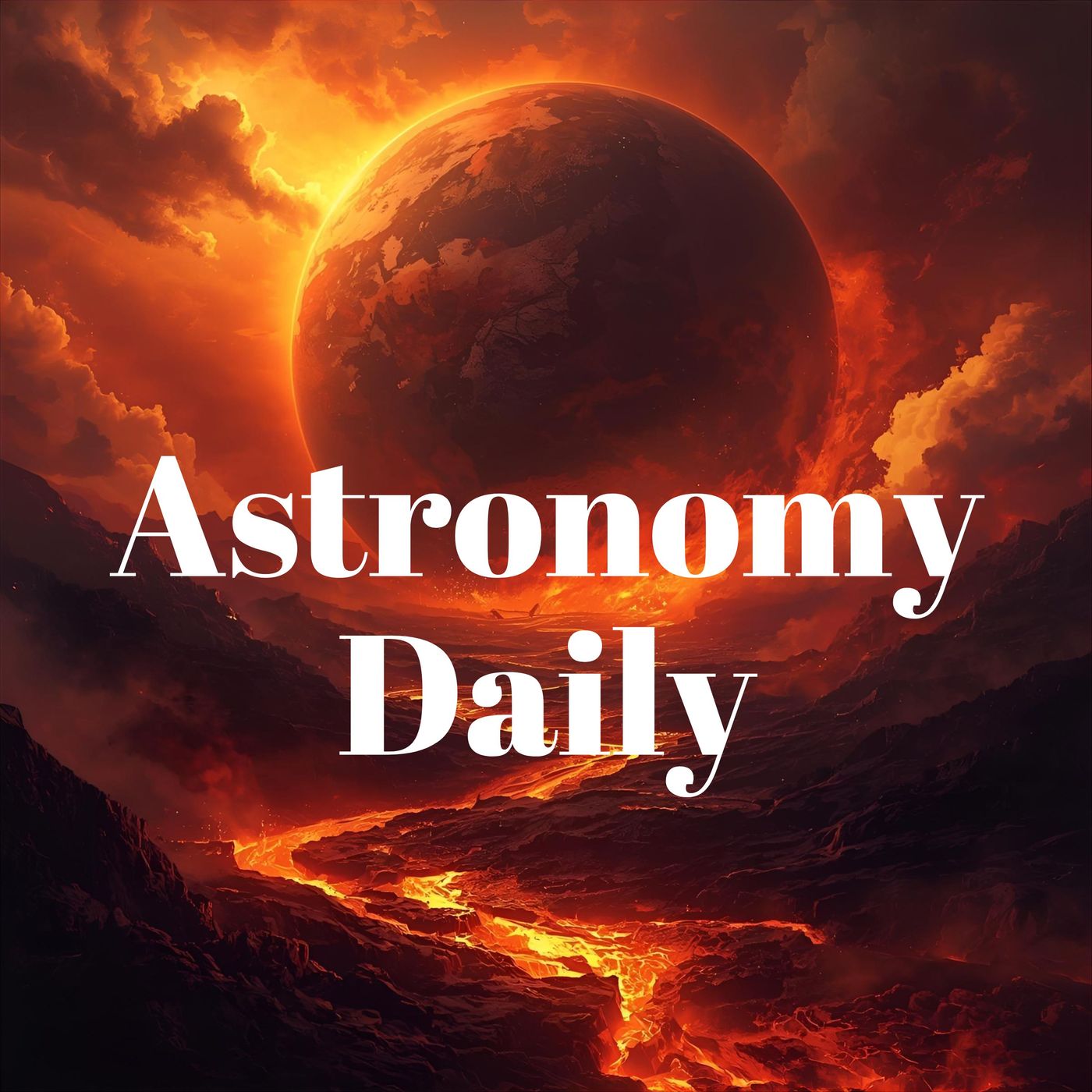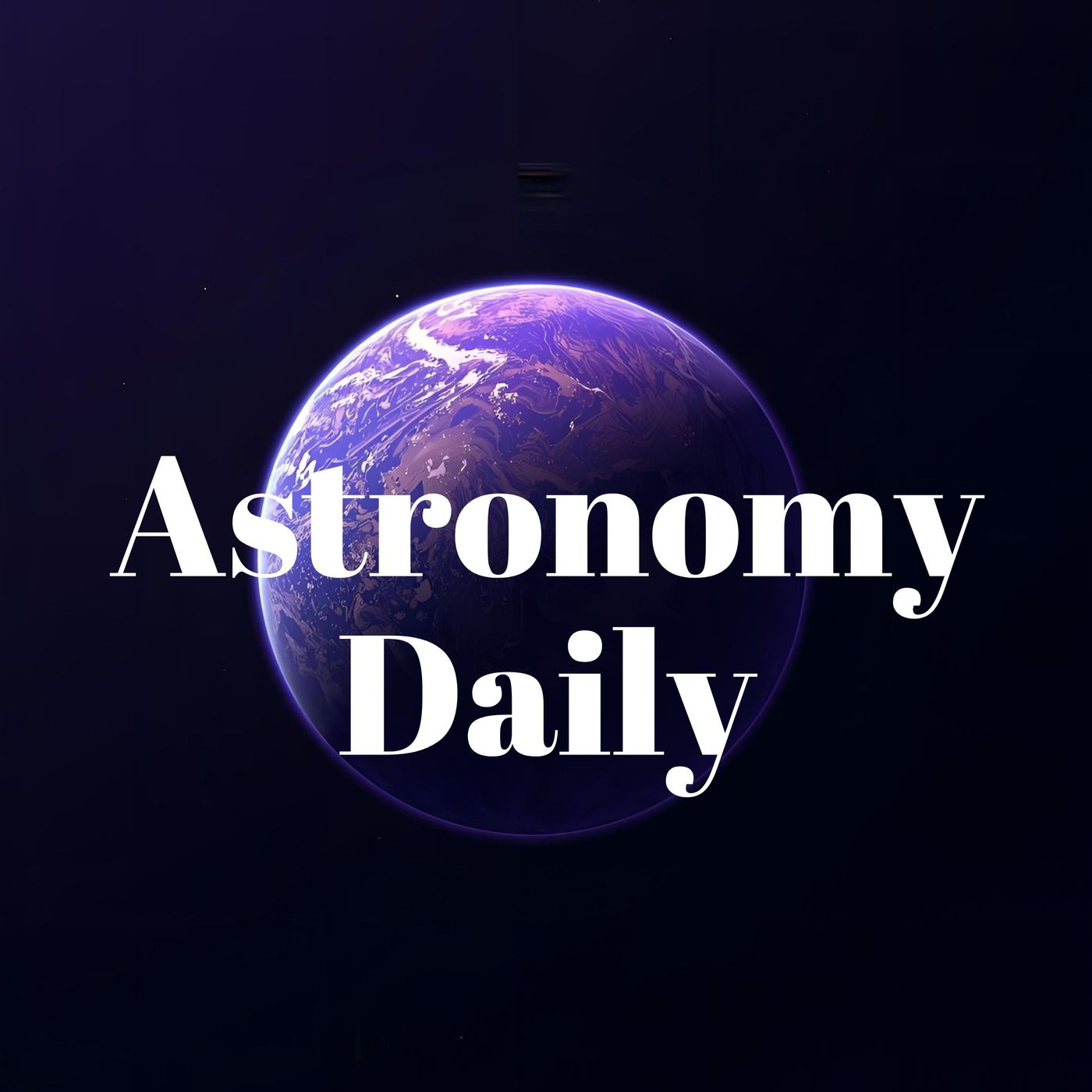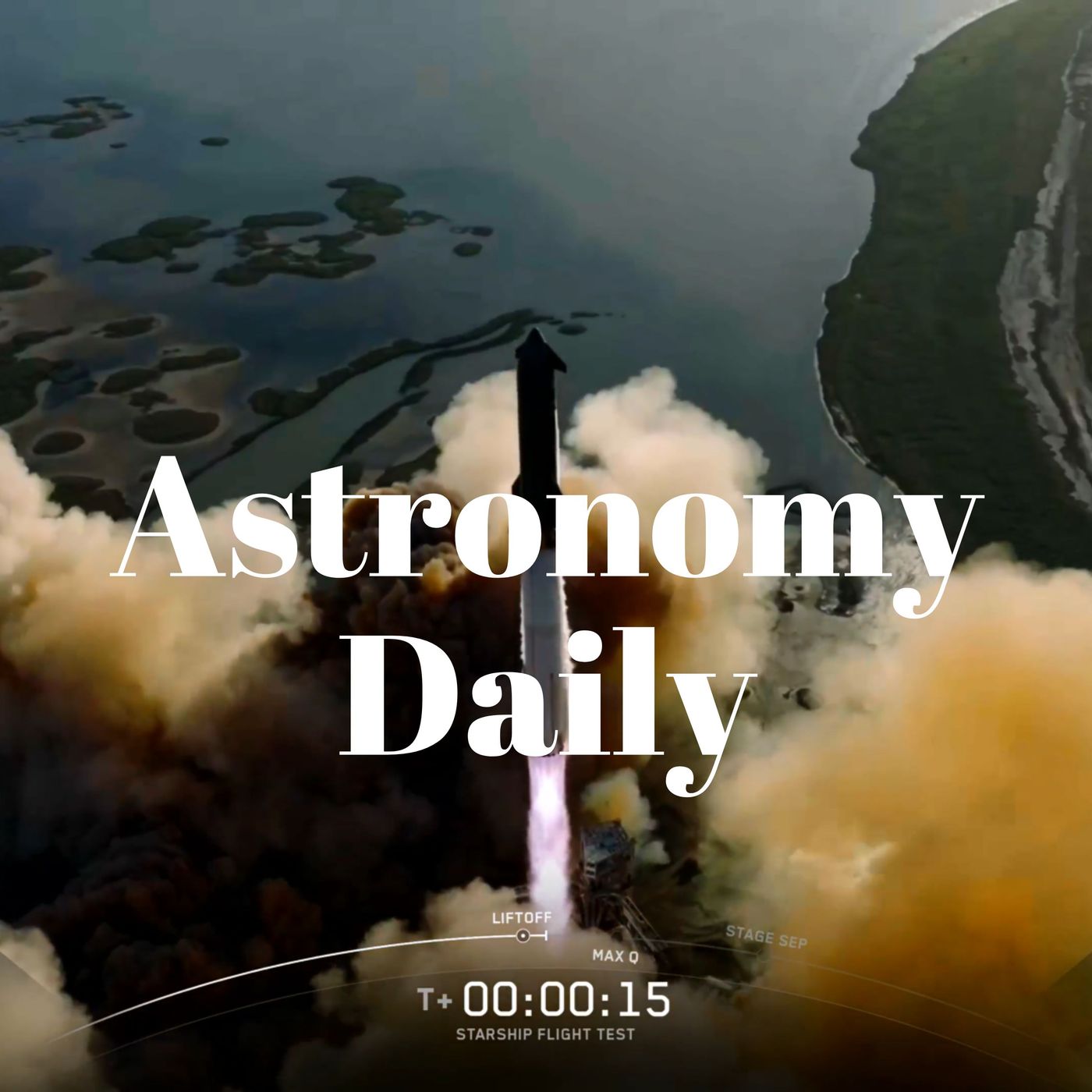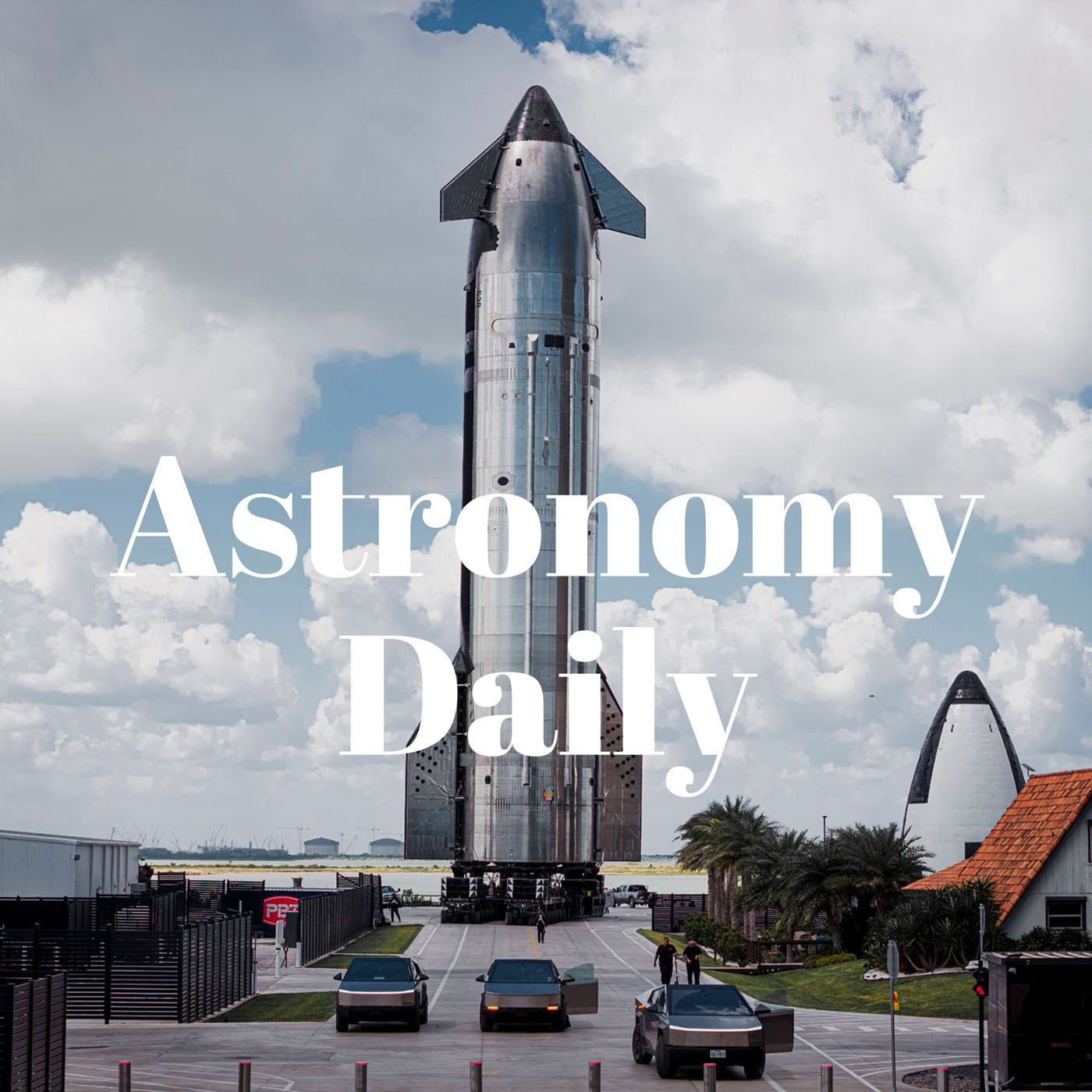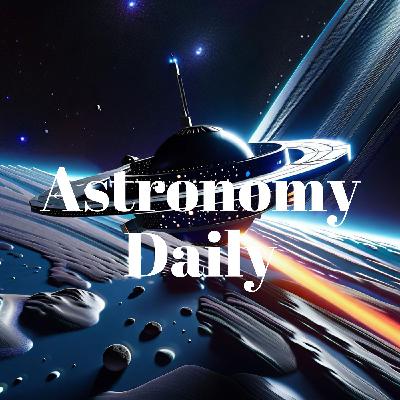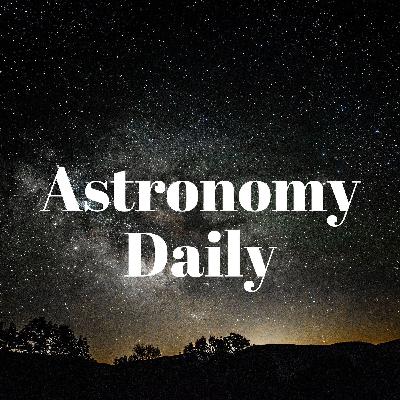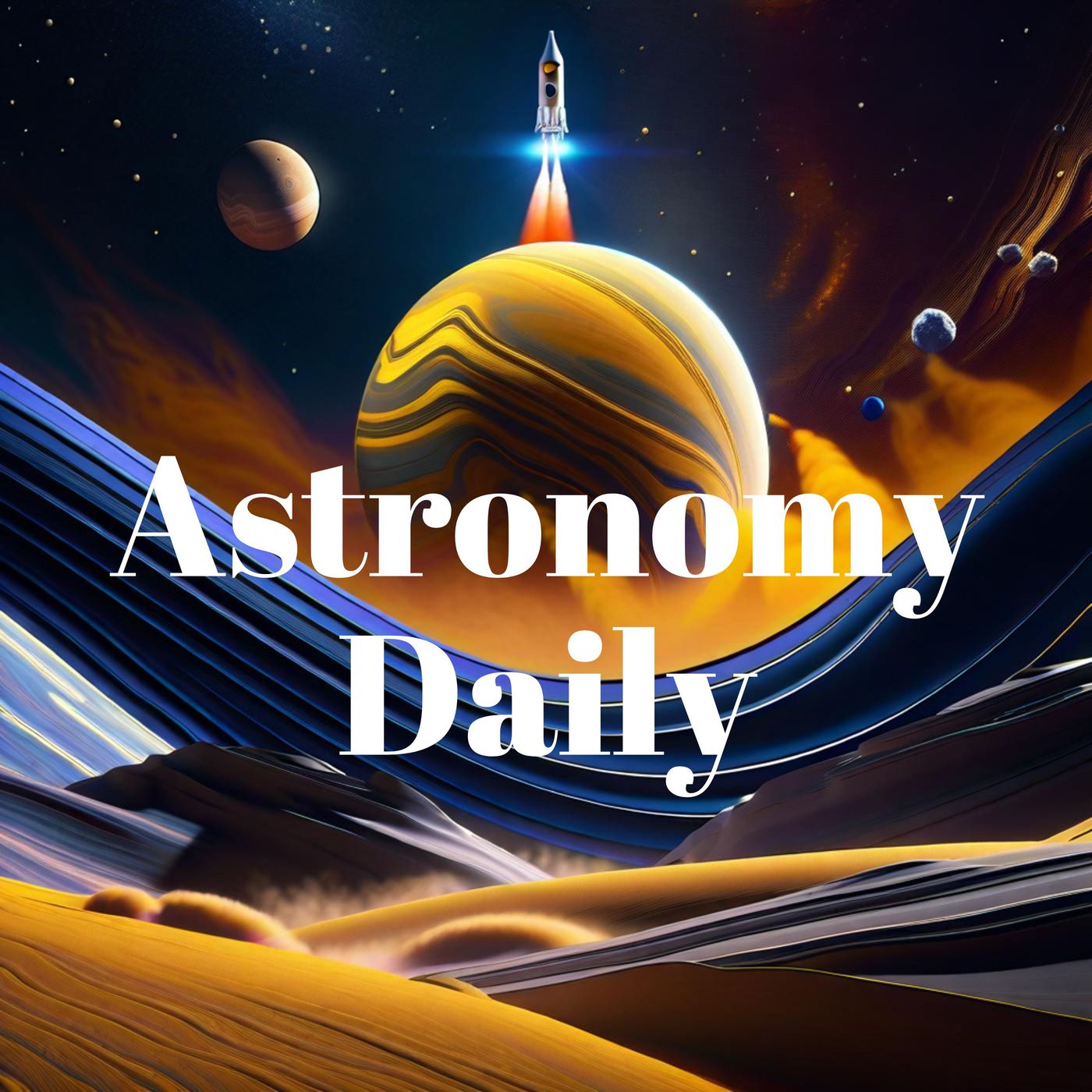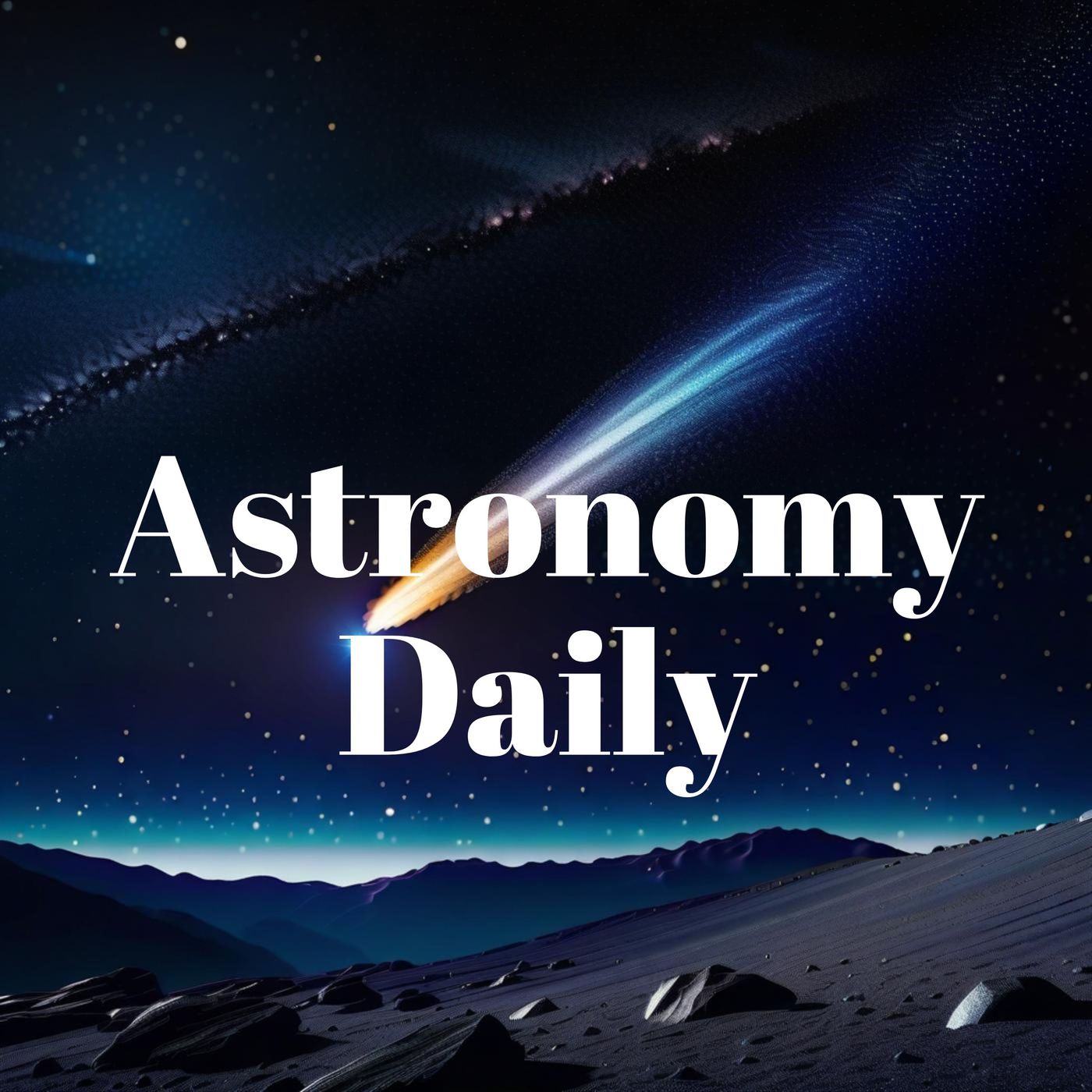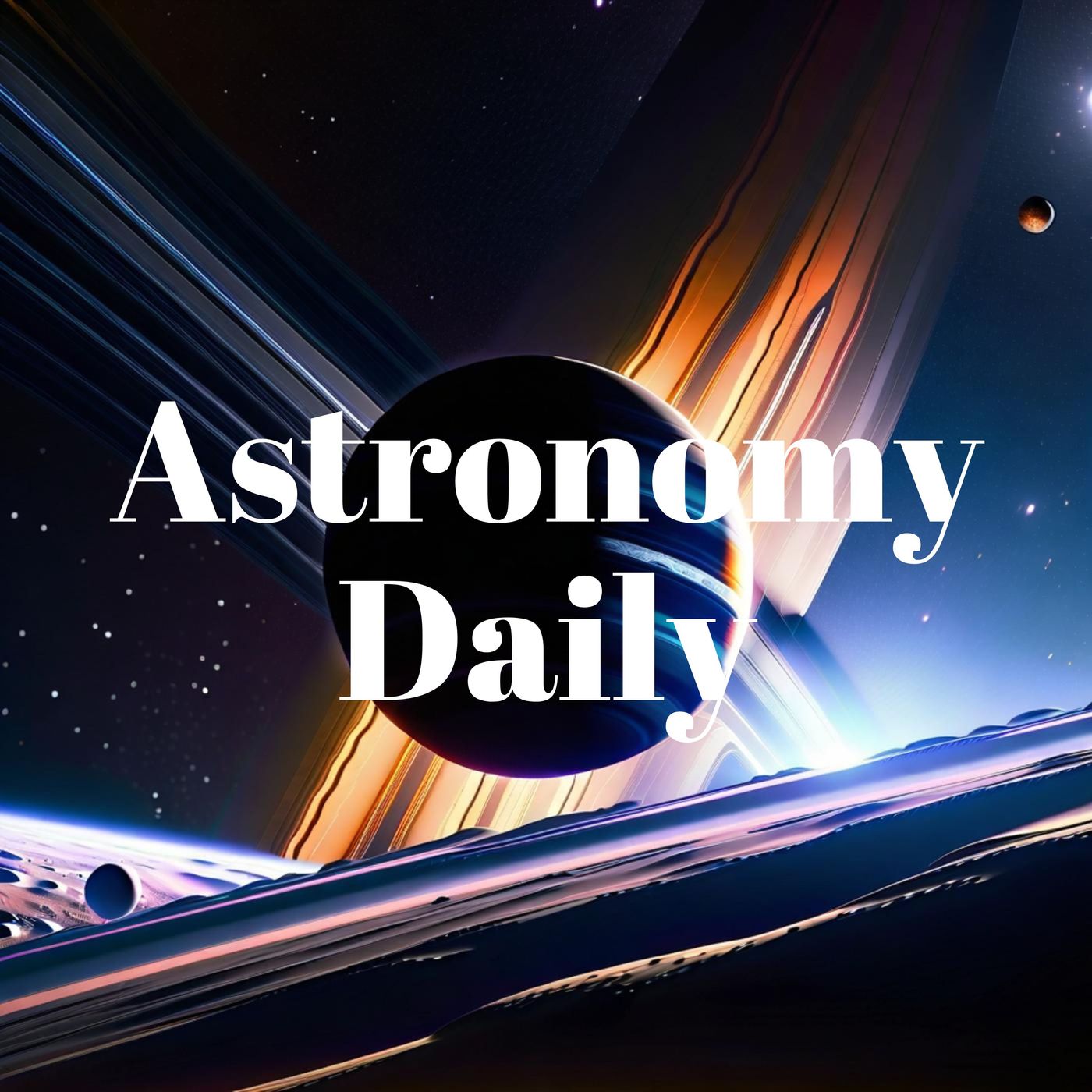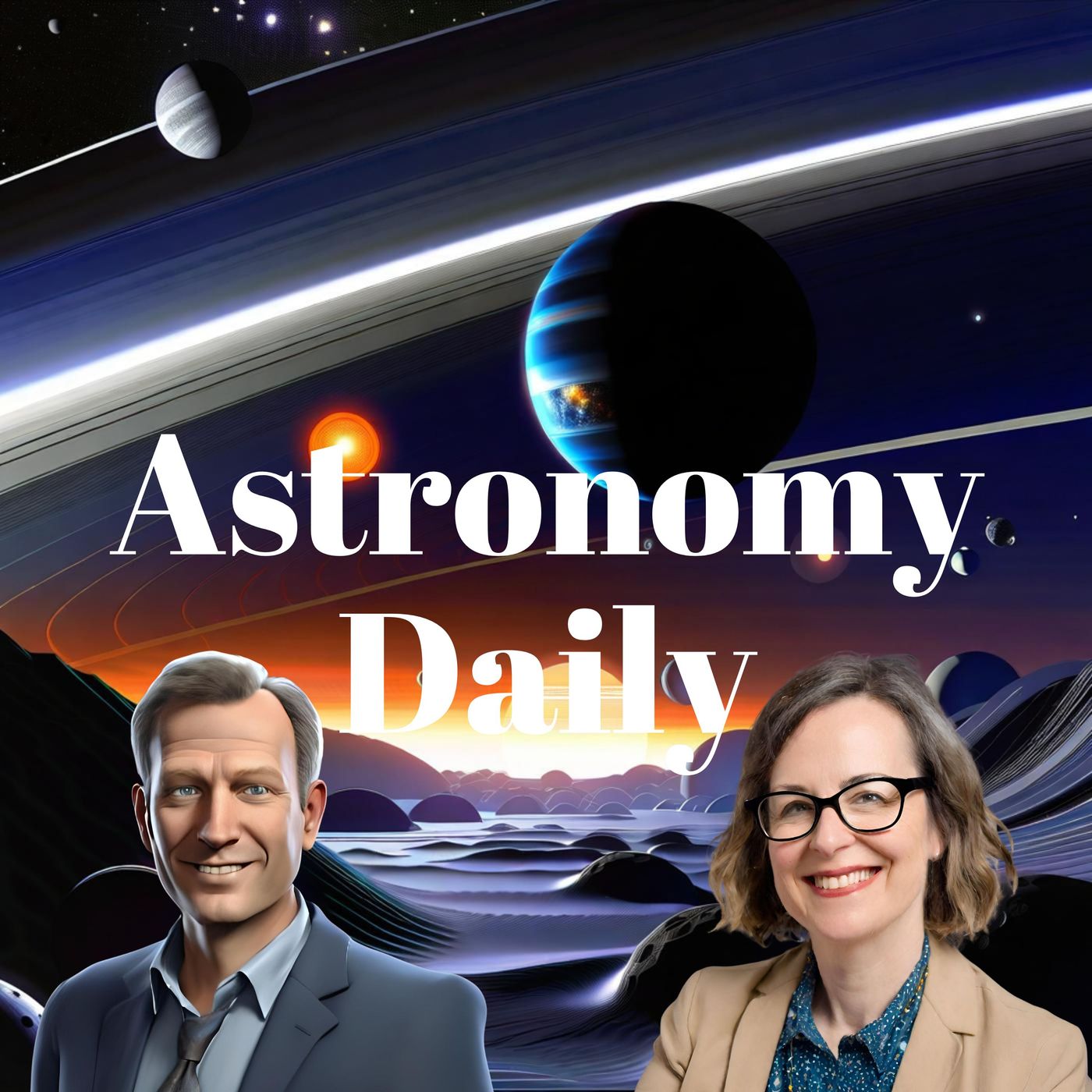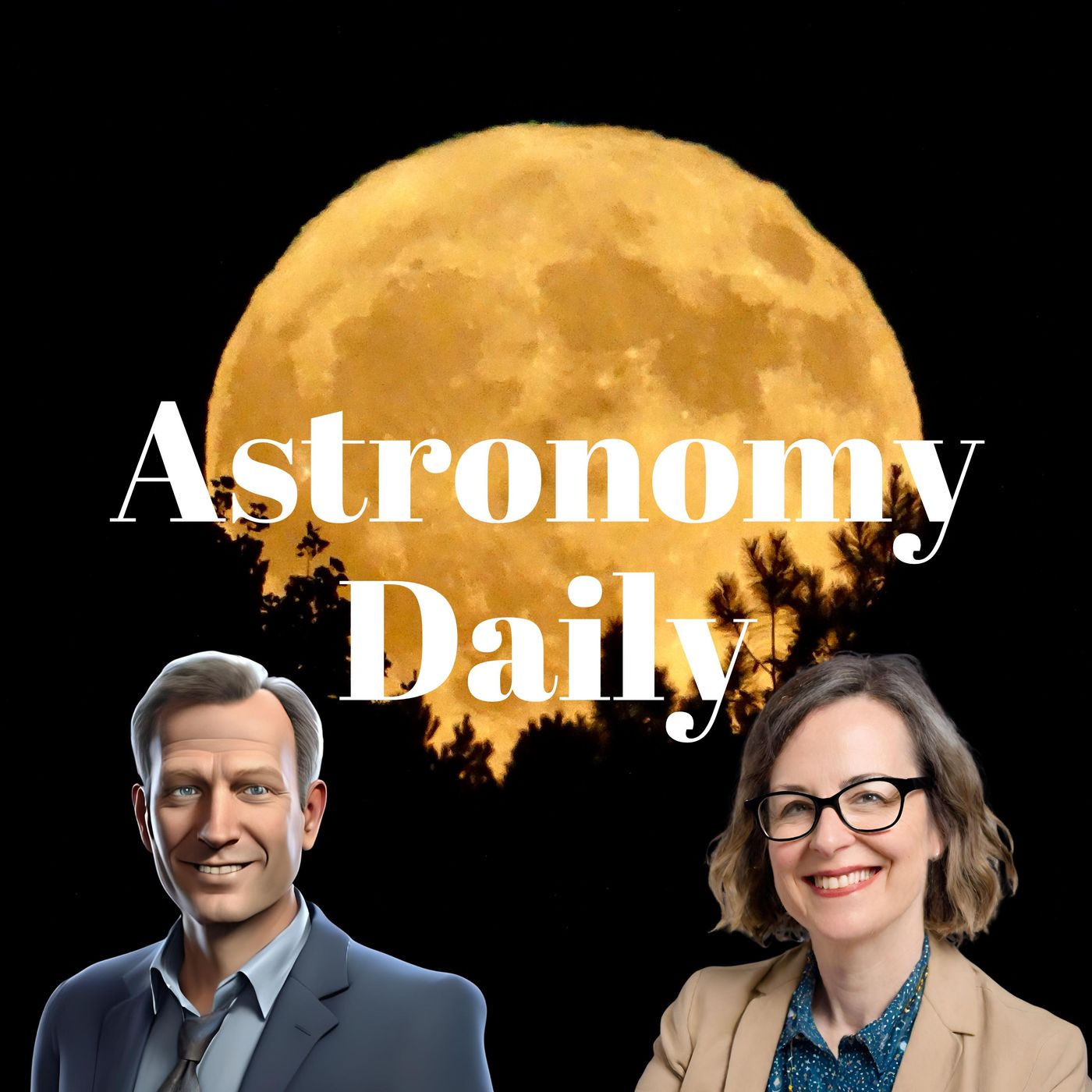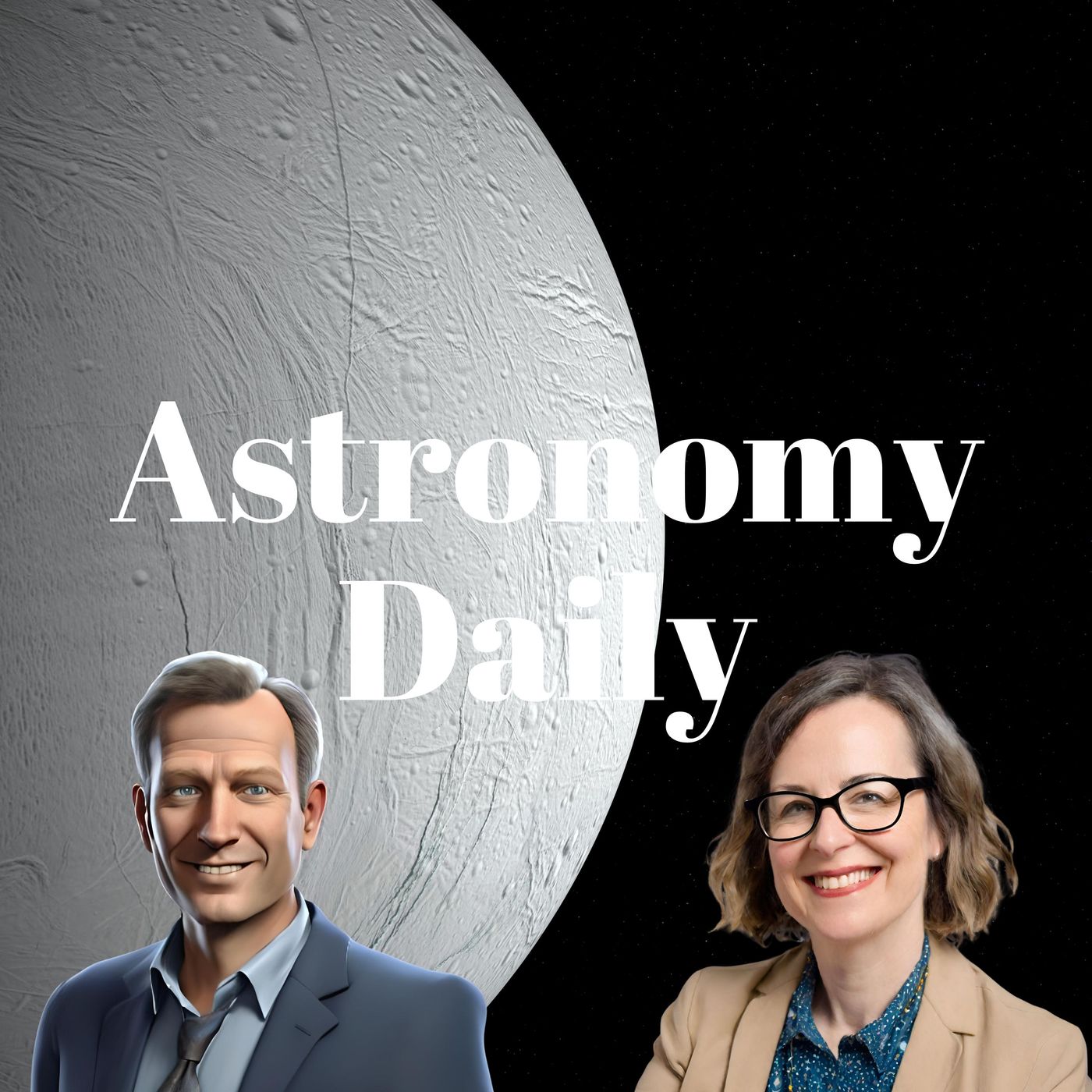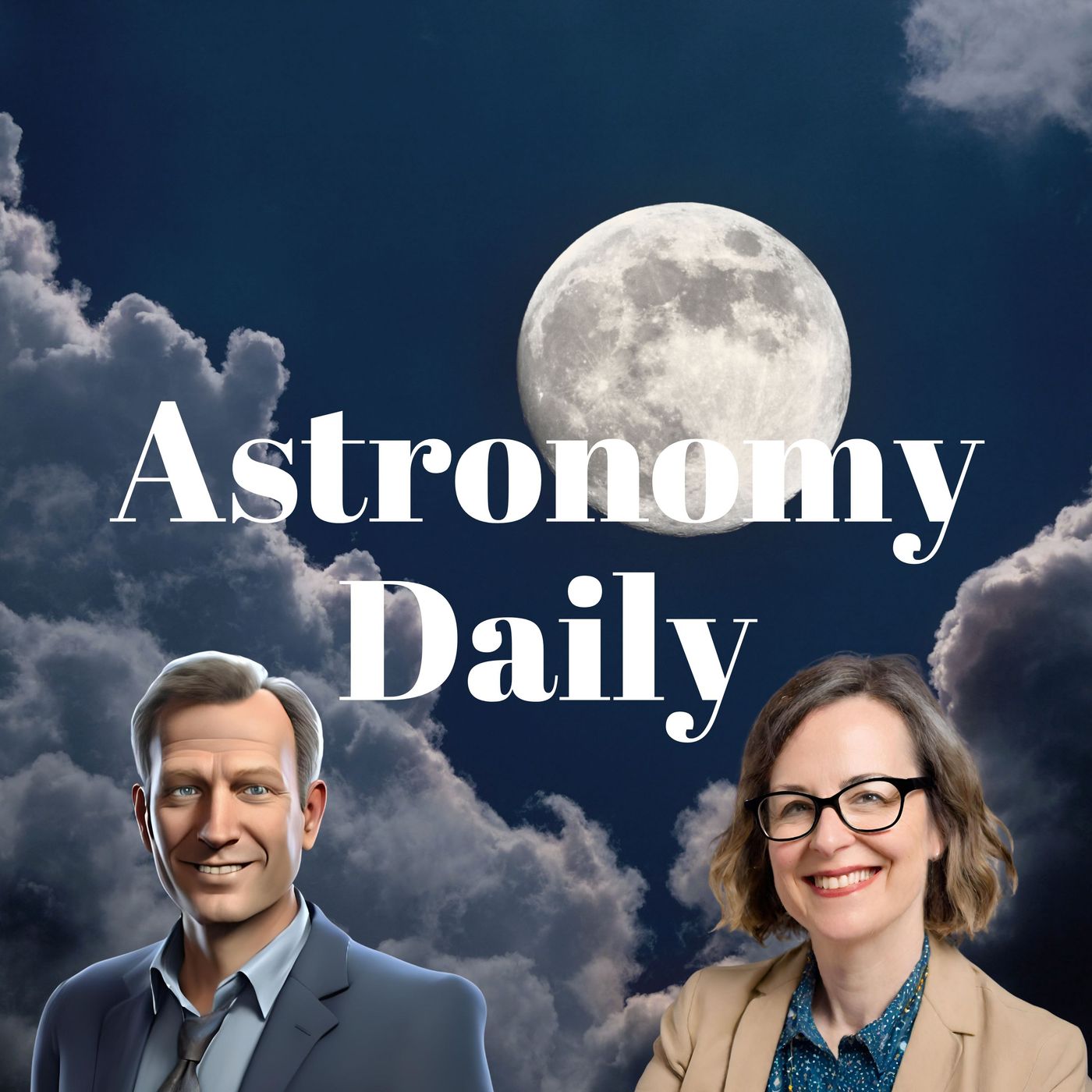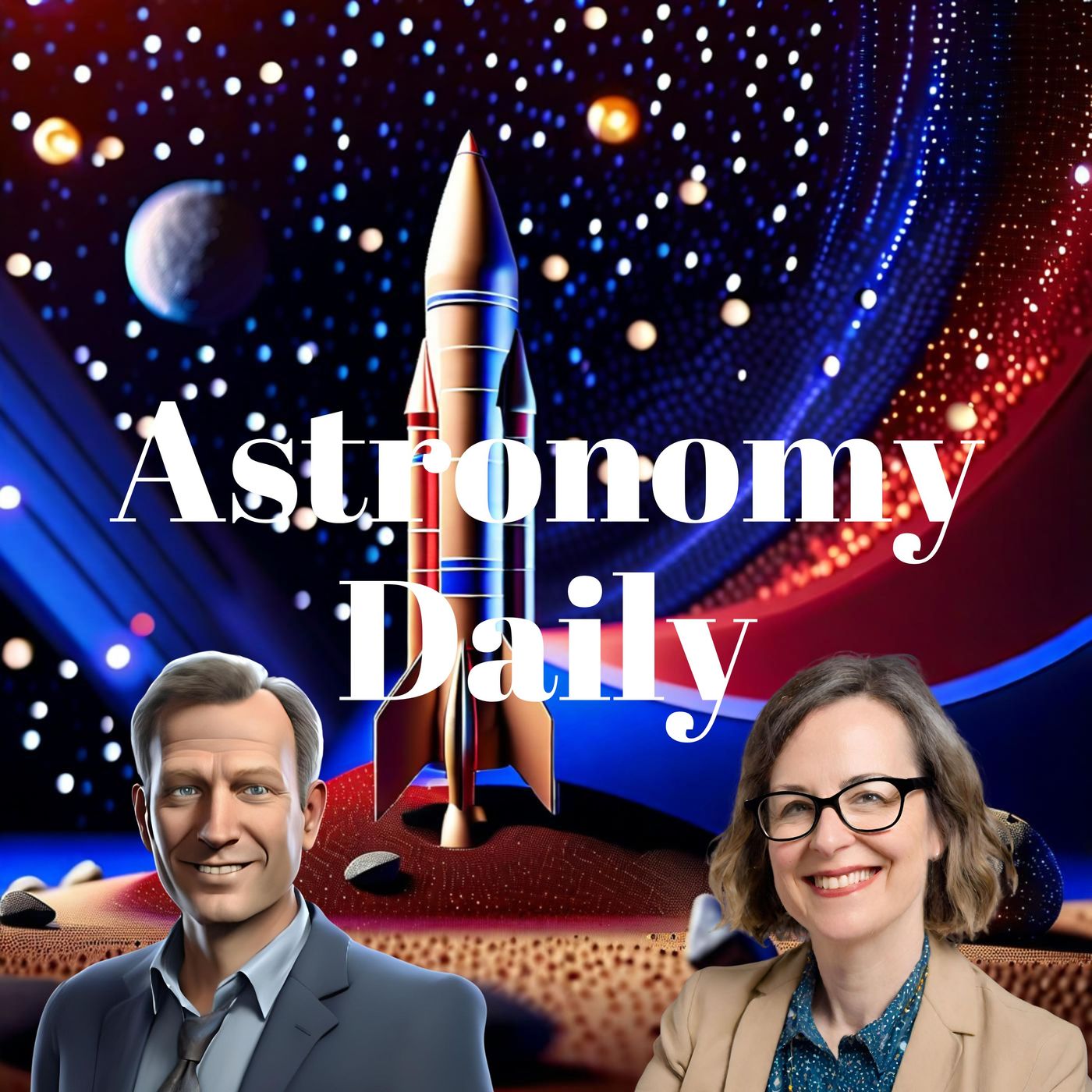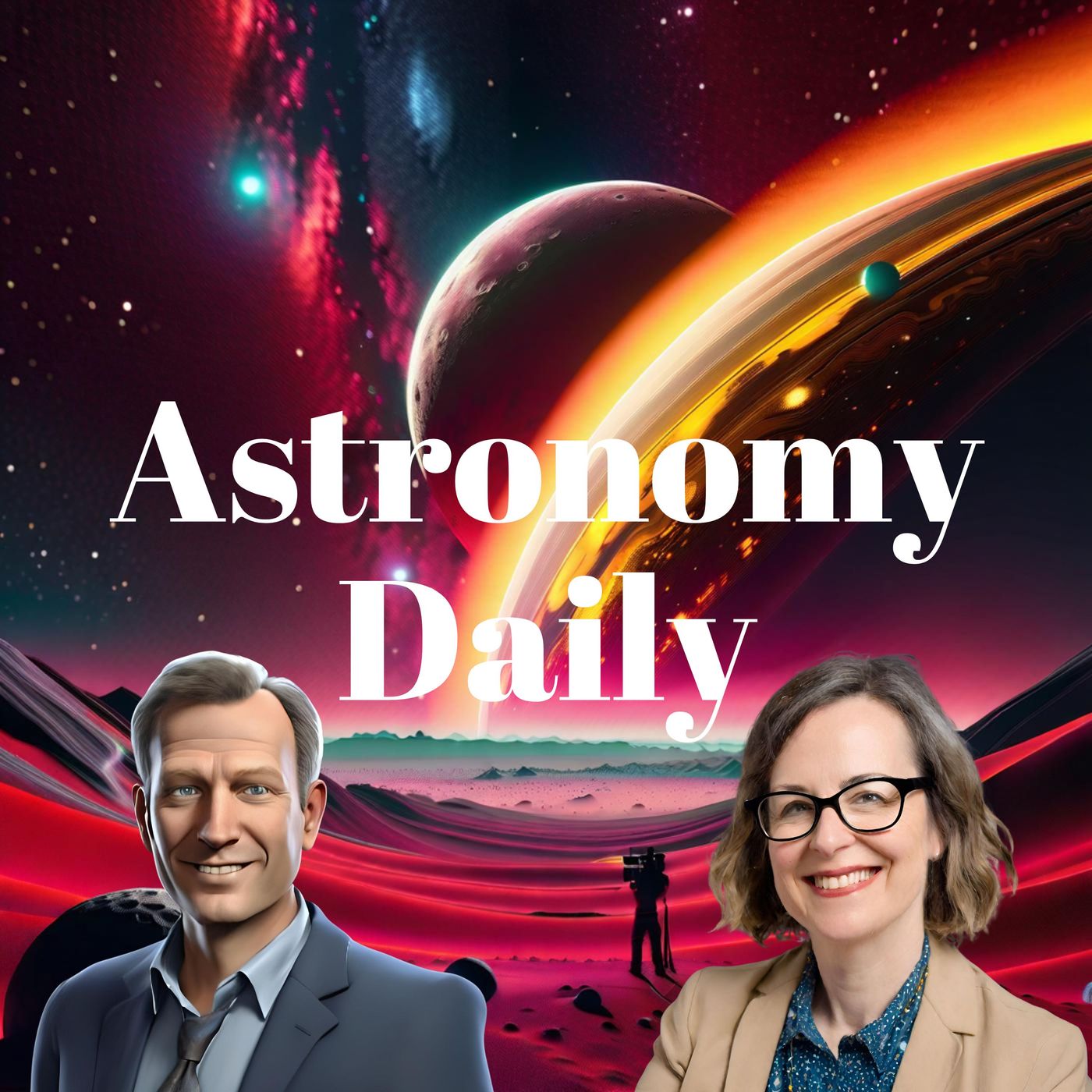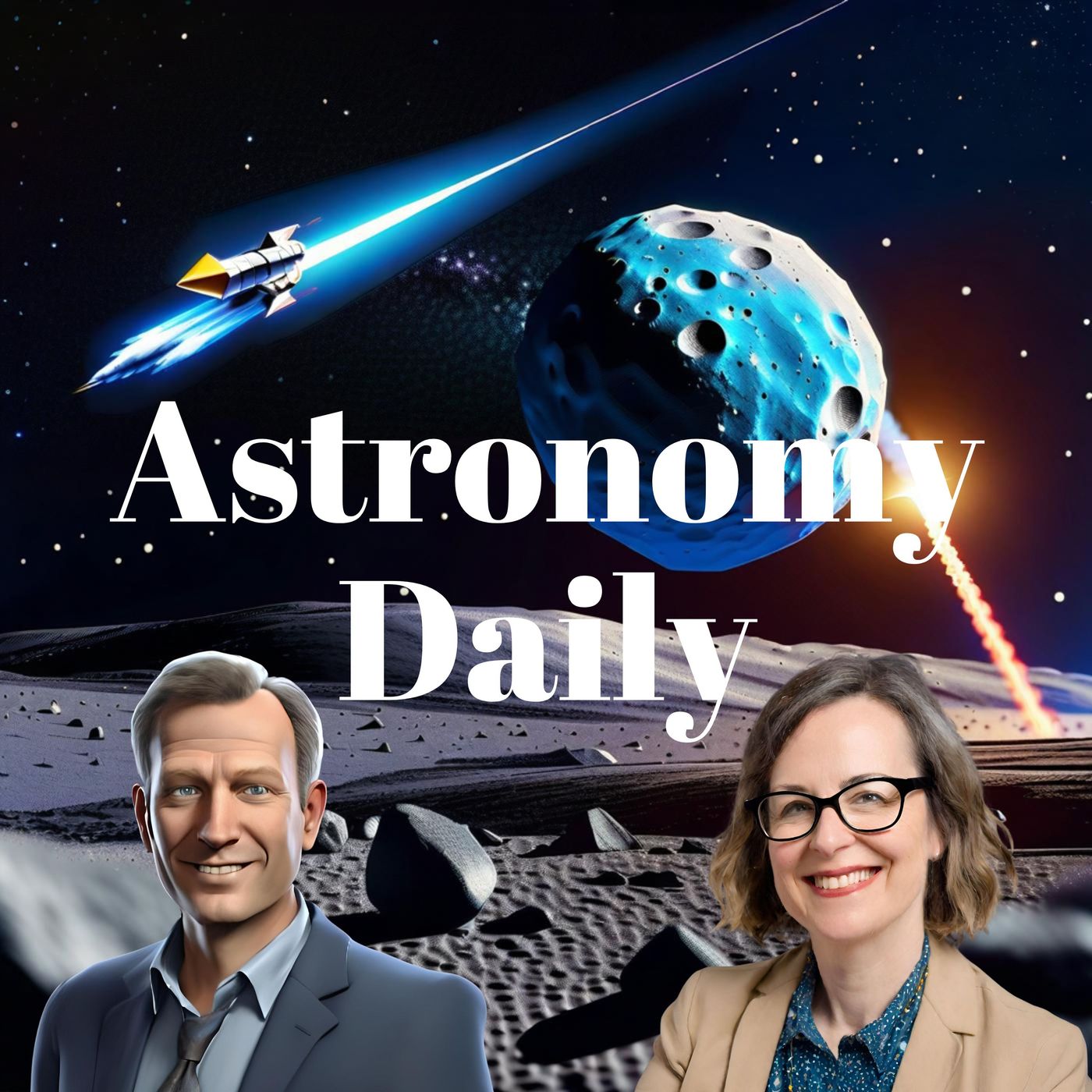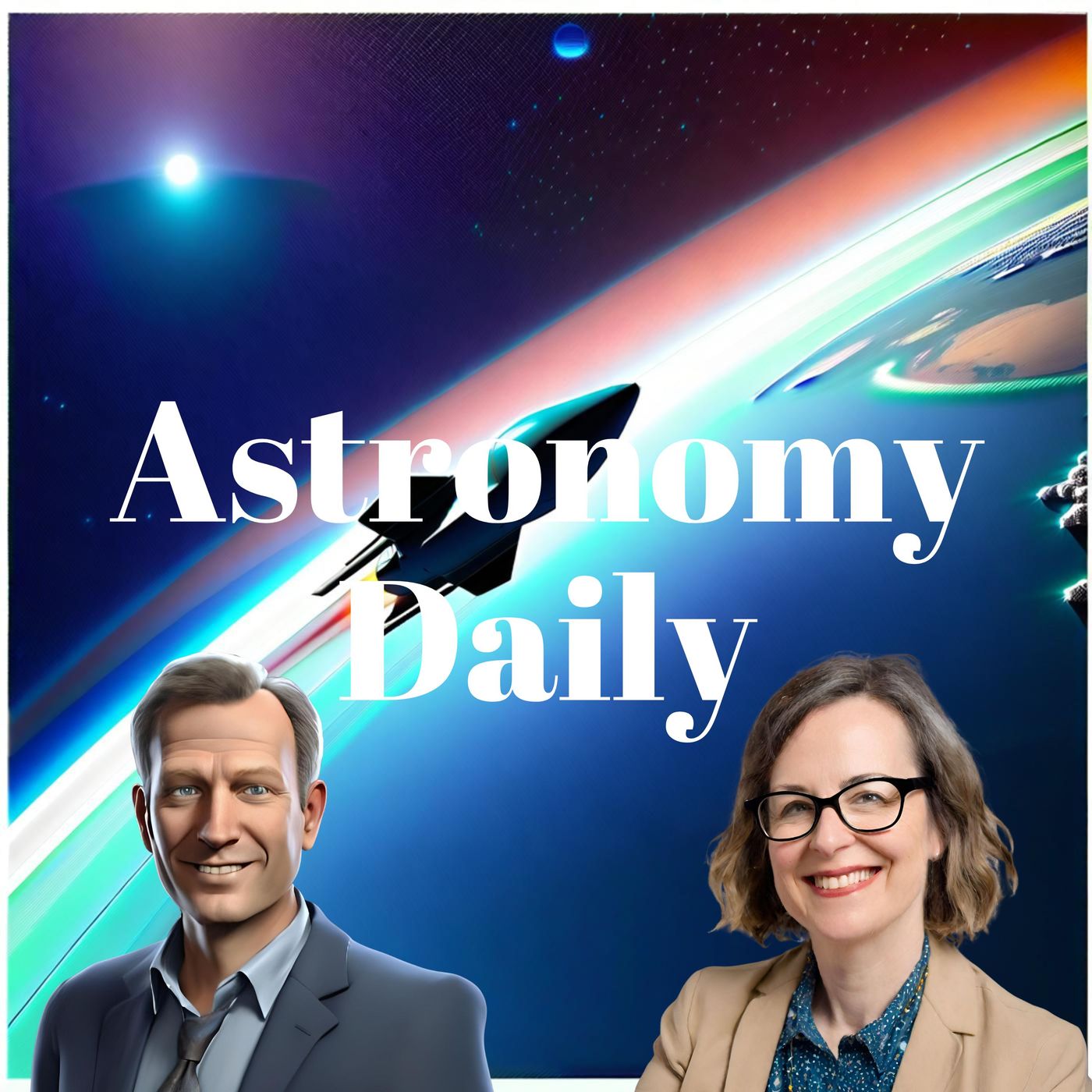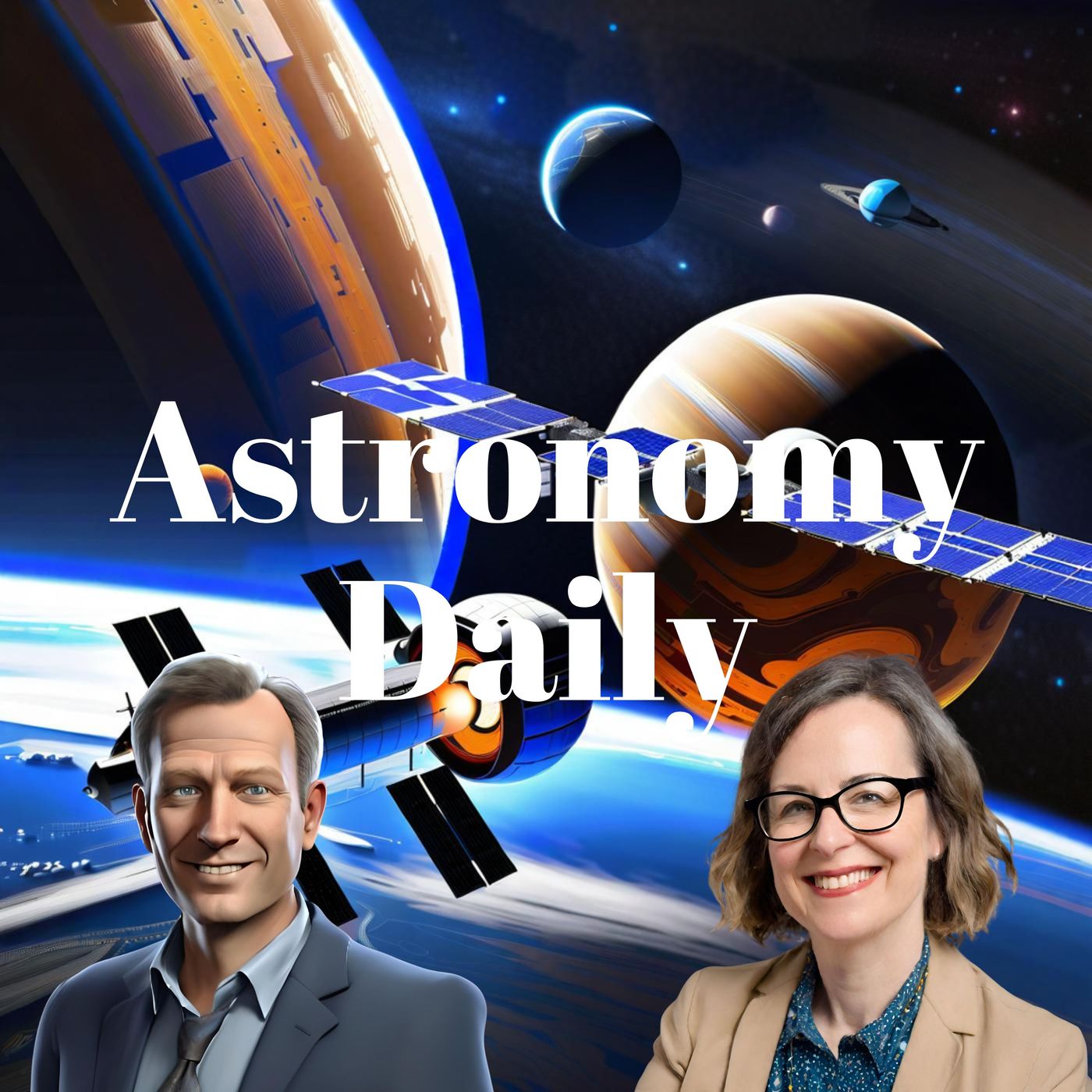Discover Astronomy Daily: Space News Updates
Astronomy Daily: Space News Updates

Astronomy Daily: Space News Updates
Author: bitesz.com
Subscribed: 110Played: 17,826Subscribe
Share
© Copyright bitesz.com
Description
Join hosts Anna & Avery for daily Space & Astronomy news, insights, and discoveries.
Give us 10 minutes and we'll give you the Universe!
For more visit, our website and sign up for the free daily newsletter and check out our continually updated newsfeed. www.astronomydaily.io.
Follow us on X (formerly Twitter), Facebook, YouTube and TikTok ...just search for AstroDailyPod. Enjoy!
Become a supporter of this podcast: https://www.spreaker.com/podcast/astronomy-daily-space-news-updates--5648921/support.
Give us 10 minutes and we'll give you the Universe!
For more visit, our website and sign up for the free daily newsletter and check out our continually updated newsfeed. www.astronomydaily.io.
Follow us on X (formerly Twitter), Facebook, YouTube and TikTok ...just search for AstroDailyPod. Enjoy!
Become a supporter of this podcast: https://www.spreaker.com/podcast/astronomy-daily-space-news-updates--5648921/support.
642 Episodes
Reverse
European Rocket Revolution: HyImpulse, a German rocket manufacturer, has secured €45 million in funding to accelerate the development of their SL1 rocket. This three-stage rocket, standing 33 meters tall, aims for its inaugural flight in 2027 and promises to enhance Europe's competitiveness in space access, especially for smaller payloads.Innovative Space Armor: Atomic 6 has introduced Space Armor, a new composite material designed to protect satellites and astronauts from space debris. This lightweight, customizable shield absorbs impacts without generating secondary fragments, potentially revolutionizing safety in low Earth orbit.Black Hole Jet Dynamics: Researchers at Goda University have shed light on how supermassive black holes produce powerful jets of plasma. Utilizing advanced simulations, they reveal the role of magnetic reconnection in enhancing energy extraction, contributing to our understanding of galaxy evolution.Inflated White Dwarfs Explained: New findings on white dwarfs in short-period binary systems indicate that tidal heating causes these stellar remnants to expand and heat up significantly. This discovery could reshape our understanding of type Ia supernova progenitors and the dynamics of binary star systems.Meteorite Misidentified as Gold: A surprising tale of an Australian prospector who mistook a 17-kilogram meteorite for a gold nugget. This H5 ordinary chondrite, dating back to the solar system's birth, highlights the serendipitous treasures that can fall from the sky.For more cosmic updates, visit our website at astronomydaily.io. Join our community on social media by searching for #AstroDailyPod on Facebook, X, YouTubeMusic, TikTok, and our new Instagram account! Don’t forget to subscribe to the podcast on Apple Podcasts, Spotify, iHeartRadio, or wherever you get your podcasts.Thank you for tuning in. This is Anna and Avery signing off. Until next time, keep looking up and exploring the wonders of our universe.✍️ Episode ReferencesHigh Impulse SL1 Rocket Development[High Impulse](https://www.highimpulse.com/)Atomic 6 Space Armor Technology[Atomic 6](https://www.atomic6.com/)Black Hole Research Insights[Goda University](https://www.godauniversity.edu/)White Dwarf Studies[Astrophysics Journal](https://www.astrophysicsjournal.com/)Meteorite Discovery Story[Geological Society](https://www.geologicalsociety.com/)Astronomy Daily[Astronomy Daily](http://www.astronomydaily.io/)Become a supporter of this podcast: https://www.spreaker.com/podcast/astronomy-daily-space-news-updates--5648921/support.Sponsor Details:Ensure your online privacy by using NordVPN. To get our special listener deal and save a lot of money, visit www.bitesz.com/nordvpn. You'll be glad you did!Become a supporter of Astronomy Daily by joining our Supporters Club. Commercial free episodes daily are only a click away... Click HereSponsor Details:Ensure your online privacy by using NordVPN. To get our special listener deal and save a lot of money, visit www.bitesz.com/nordvpn. You'll be glad you did!Become a supporter of Astronomy Daily by joining our Supporters Club. Commercial free episodes daily are only a click way... Click Here
Primordial Earth Discovery: Researchers have identified what may be the first physical traces of primordial Earth, dating back over 4.5 billion years, suggesting fragments of the planet's original materials still exist deep within the mantle. This groundbreaking study challenges previous assumptions about Earth's turbulent beginnings and the impact that formed the Moon.Dark Matter Interactions: New theoretical work proposes that dark matter might interact with normal matter through a subtle dark force, rather than solely through gravity. This concept could help explain anomalies in galaxy rotation curves and may require highly sensitive experiments to detect these weak interactions.Spotting the Andromeda Galaxy: The Andromeda Galaxy, our closest major galactic neighbor, is visible to the naked eye under dark skies. Listeners can learn how to locate it using the constellation Andromeda and the great square of Pegasus, and discover its significance as it approaches a future merger with the Milky Way.Green Fireball Meteor Over Tennessee: Residents in Tennessee witnessed a brilliant green fireball meteor, characterized by its striking emerald hue due to high concentrations of magnesium and nickel. This event offers scientists valuable insights into the composition of meteoroids and their interactions with Earth's atmosphere.Foldable Solar Sails for Space Travel: An innovative concept involving foldable solar sails for aerobraking and atmospheric reentry could revolutionize space travel. These sails would increase drag during atmospheric entry, reducing the need for propellant and allowing for more efficient missions.For more cosmic updates, visit our website at astronomydaily.io. Join our community on social media by searching for #AstroDailyPod on Facebook, X, YouTubeMusic, TikTok, and our new Instagram account! Don’t forget to subscribe to the podcast on Apple Podcasts, Spotify, iHeartRadio, or wherever you get your podcasts.Thank you for tuning in. This is Anna and Avery signing off. Until next time, keep looking up and exploring the wonders of our universe.✍️ Episode ReferencesPrimordial Earth Discovery[Nature Geoscience](https://www.nature.com/ngeo/)Dark Matter Theoretical Work[Theoretical Physics Journal](https://www.theoreticalphysicsjournal.com/)Andromeda Galaxy Viewing Guide[NASA](https://www.nasa.gov/)Green Fireball Meteor Event[Meteor Society](https://www.meteorsociety.org/)Foldable Solar Sails Innovation[Space Exploration Technologies](https://www.spacex.com/)Astronomy Daily[Astronomy Daily](http://www.astronomydaily.io/)Become a supporter of this podcast: https://www.spreaker.com/podcast/astronomy-daily-space-news-updates--5648921/support.Sponsor Details:Ensure your online privacy by using NordVPN. To get our special listener deal and save a lot of money, visit www.bitesz.com/nordvpn. You'll be glad you did!Become a supporter of Astronomy Daily by joining our Supporters Club. Commercial free episodes daily are only a click way... Click Here
Earth's Magnetic Field Changes: New data from the European Space Agency's Swarm satellites reveal significant alterations in Earth's magnetic field, including the eastward expansion of the South Atlantic Anomaly and a strengthening field over Siberia. These changes, while not alarming for life on Earth, pose challenges for satellite navigation systems and space infrastructure.Ambitious Lunar Delivery Plans: Impulse Space has announced plans to deliver up to six tons of cargo to the Moon annually, starting as early as 2028. Their new lunar lander and Helios high-energy kickstage aim to facilitate efficient lunar logistics, paving the way for sustained human presence on the lunar surface.SpaceX's Busy Week: SpaceX has had an eventful week with six Falcon 9 launches, including multiple Starlink deployments and a significant mission for the Space Development Agency. The company continues to push the boundaries of rapid iteration with their Starship program.Comet C 2025 A6 (Comet Lemmon): Astrophotographer Brennan Gilmour captured stunning images of Comet Lemmon, which recently experienced a dramatic disconnection event, shedding part of its tail due to solar wind. The comet is brightening and may become visible to the naked eye as it approaches perihelion.Purple Earth Hypothesis: New research suggests that early Earth may have appeared purple due to retinal-based photosynthesis in ancient microorganisms. This intriguing theory could reshape our understanding of early life and has implications for the search for extraterrestrial life.For more cosmic updates, visit our website at astronomydaily.io. Join our community on social media by searching for #AstroDailyPod on Facebook, X, YouTubeMusic, TikTok, and our new Instagram account! Don’t forget to subscribe to the podcast on Apple Podcasts, Spotify, iHeartRadio, or wherever you get your podcasts.Thank you for tuning in. This is Anna and Avery signing off. Until next time, keep looking up and exploring the wonders of our universe.✍️ Episode ReferencesEarth's Magnetic Field Changes[European Space Agency](https://www.esa.int/)Impulse Space Lunar Delivery Plans[Impulse Space](https://www.impulsespace.com/)SpaceX Launch Updates[SpaceX](https://www.spacex.com/)Comet Lemmon Images[Astrophotography by Brennan Gilmour](https://www.brennangilmour.com/)Purple Earth Hypothesis[Scientific Research](https://www.scientificresearch.com/)Astronomy Daily[Astronomy Daily](http://www.astronomydaily.io/)Become a supporter of this podcast: https://www.spreaker.com/podcast/astronomy-daily-space-news-updates--5648921/support.Sponsor Details:Ensure your online privacy by using NordVPN. To get our special listener deal and save a lot of money, visit www.bitesz.com/nordvpn. You'll be glad you did!Become a supporter of Astronomy Daily by joining our Supporters Club. Commercial free episodes daily are only a click way... Click Here
SpaceX's Successful Starship Test: SpaceX has achieved a monumental milestone with the successful suborbital mission of the final version 2 Starship Super Heavy rocket. This flight involved crucial testing of its heat shield and a simulated deorbit burn, paving the way for the transition to version 3 for orbital missions, essential for NASA's Artemis program.China's Advancements in Earth Observation: In a significant step for its space capabilities, China successfully launched a Long March 2D rocket carrying the Haiyang 3 satellite. This satellite is designed for marine environmental monitoring, providing critical data for climate science and resource management.Northern Taurids Meteor Shower: The Northern Taurids meteor shower is peaking around November 12, known for its bright fireballs. This year, a stronger showing is anticipated due to Jupiter's gravitational influence on the debris stream from Comet 2P Encke.New Insights from Apollo 17 Samples: NASA has opened pristine lunar samples from the Apollo 17 mission, preserved for over 50 years. Modern analytical techniques will allow scientists to study the Moon's geology and volatile compounds, crucial for future lunar missions.Urgent Need for LEO Management: A recent study highlights the critical issue of low Earth orbit congestion, emphasizing the need for international cooperation to manage the growing number of satellites and debris. Without proactive measures, the risk of catastrophic collisions could jeopardize vital space operations.For more cosmic updates, visit our website at astronomydaily.io. Join our community on social media by searching for #AstroDailyPod on Facebook, X, YouTubeMusic, TikTok, and our new Instagram account! Don’t forget to subscribe to the podcast on Apple Podcasts, Spotify, iHeartRadio, or wherever you get your podcasts.Thank you for tuning in. This is Anna and Avery signing off. Until next time, keep looking up and exploring the wonders of our universe.✍️ Episode ReferencesStarship Mission Details[NASA Spaceflight](https://www.nasaspaceflight.com/)Haiyang 3 Satellite Launch[China National Space Administration](http://www.cnsa.gov.cn)Northern Taurids Meteor Shower Insights[American Meteor Society](https://www.amsmeteors.org/)Apollo 17 Sample Analysis[NASA](https://www.nasa.gov/)LEO Congestion Study[European Space Agency](https://www.esa.int/)Astronomy Daily[Astronomy Daily](http://www.astronomydaily.io/)Become a supporter of this podcast: https://www.spreaker.com/podcast/astronomy-daily-space-news-updates--5648921/support.Sponsor Details:Ensure your online privacy by using NordVPN. To get our special listener deal and save a lot of money, visit www.bitesz.com/nordvpn. You'll be glad you did!Become a supporter of Astronomy Daily by joining our Supporters Club. Commercial free episodes daily are only a click way... Click Here
SpaceX's Starship Flight 11: NASA spaceflight has reported that SpaceX is gearing up for Starship Flight 11, marking the final launch from Pad 1A in its current configuration. This mission will transition SpaceX to the advanced Block 3 designs, utilizing booster 152 and ship 38 to test engine redundancy and heat shield performance.Terraforming Mars Feasibility: A recent workshop summary suggests that advancements in launch costs, synthetic biology, and climate modeling have made the dream of terraforming Mars more feasible than ever. The proposed process includes warming the planet, introducing extremophiles, and eventually creating an oxygen-rich atmosphere for complex life.Discovery of Betel Buddy: Researchers have confirmed the existence of a companion star to Betelgeuse, affectionately named Betel Buddy. This discovery, utilizing advanced instruments like the Hubble Telescope, sheds light on the mysterious dimming cycles of Betelgeuse and challenges existing binary star formation theories.Microbial Resilience in Space: A groundbreaking study from RMIT University reveals that Bacillus subtilis spores can survive the extreme conditions of spaceflight, demonstrating resilience that could support astronaut health and sustainable life support systems on long-duration missions to the Moon and Mars.Mysterious Sounds in Space: The Daily Galaxy revisits the eerie knocking sounds reported by China's first astronaut, Jingle during his 2003 mission. These sounds, described as akin to a wooden hammer, have been echoed by other astronauts and remain an unsolved mystery in the realm of space exploration.For more cosmic updates, visit our website at astronomydaily.io. Join our community on social media by searching for #AstroDailyPod on Facebook, X, YouTubeMusic, TikTok, and our new Instagram account! Don’t forget to subscribe to the podcast on Apple Podcasts, Spotify, iHeartRadio, or wherever you get your podcasts.Thank you for tuning in. This is Anna and Avery signing off. Until next time, keep looking up and exploring the wonders of our universe.✍️ Episode ReferencesStarship Flight 11 Details[NASA Spaceflight](https://www.nasaspaceflight.com/)Terraforming Mars Insights[Universe Today](https://www.universetoday.com/)Betel Buddy Discovery[Carnegie Mellon University](https://www.cmu.edu/)Microbial Resilience Study[RMIT University](https://www.rmit.edu.au/)Mysterious Sounds in Space[The Daily Galaxy](https://www.dailygalaxy.com/)Astronomy Daily[Astronomy Daily](http://www.astronomydaily.io/)Become a supporter of this podcast: https://www.spreaker.com/podcast/astronomy-daily-space-news-updates--5648921/support.Sponsor Details:Ensure your online privacy by using NordVPN. To get our special listener deal and save a lot of money, visit www.bitesz.com/nordvpn. You'll be glad you did!Become a supporter of Astronomy Daily by joining our Supporters Club. Commercial free episodes daily are only a click way... Click Here
New Satellite Factory in Italy: Thales Alenia Space has inaugurated a €100 million satellite factory in Rome, marking a significant step in Italy's Space Factory 4.0 initiative. This facility will focus on producing micro and small satellites, enhancing Europe's competitiveness in the growing space market.Record-Breaking Space Investments: Global space investment has skyrocketed to $3.5 billion in Q3 2025, nearly double last year’s figures. This surge is driven by diverse startups and advancements in AI and defense technologies, signaling a maturing space economy.Interstellar Comet 3I Atlas: NASA's Swift observatory has captured the first evidence of water venting from interstellar comet 3I Atlas. This discovery provides insights into the chemical makeup of other planetary systems, suggesting that the ingredients for life may be more widespread than previously thought.First Radio Image of Binary Black Holes: Astronomers have achieved a groundbreaking milestone by capturing the first radio image of two supermassive black holes orbiting each other in the quasar OJ287. This visual proof helps validate theories of binary black hole formation and enhances our understanding of galaxy evolution.Subsurface Ocean on Saturn's Moon Mimas: Recent research indicates that Saturn's moon Mimas may harbor a young subsurface ocean formed within the last 10 to 15 million years. This discovery challenges our perceptions of icy moons and opens new avenues for exploration in the Saturnian system.For more cosmic updates, visit our website at astronomydaily.io. Join our community on social media by searching for #AstroDailyPod on Facebook, X, YouTubeMusic, TikTok, and our new Instagram account! Don’t forget to subscribe to the podcast on Apple Podcasts, Spotify, iHeartRadio, or wherever you get your podcasts.Thank you for tuning in. This is Anna and Avery signing off. Until next time, keep looking up and exploring the wonders of our universe.✍️ Episode ReferencesSatellite Factory Launch[Thales Alenia Space](https://www.thalesgroup.com/en/global/activities/space)Space Investment Robert[Seraphim Space](https://seraphimcapital.co.uk/)Interstellar Comet Findings[NASA](https://www.nasa.gov/)Binary Black Holes Research[Astrophysical Journal](https://iopscience.iop.org/journal/0004-637X)Mimas Ocean Study[Southwest Research Institute](https://www.swri.org/)Astronomy Daily[Astronomy Daily](http://www.astronomydaily.io/)Become a supporter of this podcast: https://www.spreaker.com/podcast/astronomy-daily-space-news-updates--5648921/support.Sponsor Details:Ensure your online privacy by using NordVPN. To get our special listener deal and save a lot of money, visit www.bitesz.com/nordvpn. You'll be glad you did!Become a supporter of Astronomy Daily by joining our Supporters Club. Commercial free episodes daily are only a click way... Click Here
Estimating Stars in the Milky Way: Astronomers estimate that our galaxy contains around 100 billion stars, a number that evolves as observational techniques improve. By studying luminosity and mass, scientists refine these estimates, revealing the complexities of counting stars from within our own galaxy.Asteroid Rotation Dynamics: New research uncovers why some asteroids spin smoothly while others tumble chaotically. The study highlights the impact of collisions and internal friction, demonstrating how size and composition influence an asteroid's stability and rotation.China's Space Program Updates: China's Tiangong Space Station is bustling with activity, having recently completed its fourth spacewalk and preparing for the Shenzhou 21 mission. Additionally, the Tianwen 2 probe is on its way to collect samples from Near Earth asteroid Kamo Oalewa, marking significant advancements in China's space exploration efforts.Mysterious Dark Object Detected: Astronomers have detected a dark object through its gravitational effects, potentially a rogue black hole or neutron star. This groundbreaking discovery utilizes microlensing to observe how the object's gravity warps light from distant stars, offering new insights into dark matter and galactic structures.For more cosmic updates, visit our website at astronomydaily.io. Join our community on social media by searching for #AstroDailyPod on Facebook, X, YouTubeMusic, TikTok, and our new Instagram account! Don’t forget to subscribe to the podcast on Apple Podcasts, Spotify, iHeartRadio, or wherever you get your podcasts.Thank you for tuning in. This is Anna and Avery signing off. Until next time, keep looking up and exploring the wonders of our universe.✍️ Episode ReferencesMilky Way Star Estimates[NASA](https://www.nasa.gov/)Asteroid Research Insights[European Space Agency](https://www.esa.int/)China's Space Missions[China National Space Administration](http://www.cnsa.gov.cn)Dark Object Detection[Astrophysical Journal](https://iopscience.iop.org/journal/0004-637X)Astronomy Daily[Astronomy Daily](http://www.astronomydaily.io/)Become a supporter of this podcast: https://www.spreaker.com/podcast/astronomy-daily-space-news-updates--5648921/support.Sponsor Details:Ensure your online privacy by using NordVPN. To get our special listener deal and save a lot of money, visit www.bitesz.com/nordvpn. You'll be glad you did!Become a supporter of Astronomy Daily by joining our Supporters Club. Commercial free episodes daily are only a click way... Click Here
Reclassification of Uranus and Neptune: New research from the University of Zurich challenges the long-held belief that Uranus and Neptune are ice giants. Advanced computer models suggest these planets may actually be rock giants, altering our understanding of their formation and evolution. This groundbreaking finding could necessitate a reevaluation of how we classify exoplanets, as well.Blue Origin's Upcoming Launch: Blue Origin is set to make headlines with its New Shepard suborbital vehicle, vital for expanding humanity's access to space. Each launch contributes crucial data that enhances safety and prepares for more ambitious missions, including the upcoming New Glenn rocket, which aims to support lunar missions.Philosophical Reflections on Humanity's Place: As we explore the cosmos, we confront profound questions about our existence and uniqueness. The search for extraterrestrial life and studies of dark matter and energy drive our understanding of where we fit in the grand cosmic tapestry.Dust Devils on Mars: European Space Agency orbiters have mapped over 1,000 dust devils on Mars, revealing they can reach speeds of up to 98 mph. This data is crucial for future Mars missions, helping scientists refine atmospheric models and improve weather forecasts for sustained human presence on the planet.For more cosmic updates, visit our website at astronomydaily.io. Join our community on social media by searching for #AstroDailyPod on Facebook, X, YouTubeMusic, TikTok, and our new Instagram account! Don’t forget to subscribe to the podcast on Apple Podcasts, Spotify, iHeartRadio, or wherever you get your podcasts.Thank you for tuning in. This is Anna and Avery signing off. Until next time, keep looking up and exploring the wonders of our universe.✍️ Episode ReferencesUranus and Neptune Research[University of Zurich](https://www.uzh.ch/en.html)Blue Origin Launch Details[Blue Origin](https://www.blueorigin.com/)Humanity's Cosmic Inquiry[NASA](https://www.nasa.gov/)Mars Dust Devils Study[European Space Agency](https://www.esa.int/)Astronomy Daily[Astronomy Daily](http://www.astronomydaily.io/)Become a supporter of this podcast: https://www.spreaker.com/podcast/astronomy-daily-space-news-updates--5648921/support.Sponsor Details:Ensure your online privacy by using NordVPN. To get our special listener deal and save a lot of money, visit www.bitesz.com/nordvpn. You'll be glad you did!Become a supporter of Astronomy Daily by joining our Supporters Club. Commercial free episodes daily are only a click way... Click Here
Comet C/2025 A6 LEMMON Shines Bright: This October, Comet C/2025 A6 LEMMON makes a stunning encore appearance alongside Comet R2 Swan, offering a spectacular view for observers. Currently brightening, A6 LEMMON is set to reach perihelion on November 8th, providing an excellent opportunity for binocular enthusiasts to catch a glimpse of this celestial wanderer.Interstellar Comet 3I Atlas: The fascinating interstellar comet 3I Atlas is also on the radar, known for its unusual backward-looking tail due to internal activity. With an estimated age of 3 to 14 billion years, it offers a glimpse into the early universe's history as it approaches perihelion on October 29th and passes near Venus in early November.Warm Early Universe Discovery: New research reveals that the early universe was unexpectedly warmer than previously thought, particularly during the epoch of reionization. This finding, based on a decade of data analysis, reshapes our understanding of the conditions that allowed the first stars and galaxies to form.Solar Rain Uncovered: Scientists have solved the mystery of solar rain, discovering that cooler, denser plasma clumps descend from the sun's corona. This breakthrough challenges previous models and enhances our understanding of solar dynamics, potentially improving space weather predictions.Launch Roundup: SpaceX dominates the launch schedule with five Falcon 9 missions this week, including Starlink satellite deployments and Amazon's Project Kuiper. Blue Origin also contributes with its New Shepard mission, marking significant advancements in suborbital space travel.Ground-Based Imaging Breakthrough: Astronomers at Johns Hopkins have developed a new algorithm that enhances ground-based telescope images to match space telescope clarity. This innovative technique could revolutionize ground-based astronomy, allowing for deeper, clearer observations of the cosmos.For more cosmic updates, visit our website at astronomydaily.io. Join our community on social media by searching for #AstroDailyPod on Facebook, X, YouTubeMusic, TikTok, and our new Instagram account! Don’t forget to subscribe to the podcast on Apple Podcasts, Spotify, iHeartRadio, or wherever you get your podcasts.Thank you for tuning in. This is Anna and Avery signing off. Until next time, keep looking up and exploring the wonders of our universe.✍️ Episode ReferencesComet C/2025 A6 LEMMON Details[NASA](https://www.nasa.gov/)Interstellar Comet 3I Atlas Observations[NASA](https://www.nasa.gov/)Early Universe Research[Murchison Wide Field Array](https://www.mwfa.edu.au/)Solar Rain Study[University of Hawaii](https://www.hawaii.edu/)Space Launch Updates[SpaceX](https://www.spacex.com/)Ground-Based Imaging Algorithm[Johns Hopkins University](https://www.jhu.edu/)Astronomy Daily[Astronomy Daily](http://www.astronomydaily.io/) Become a supporter of this podcast: https://www.spreaker.com/podcast/astronomy-daily-space-news-updates--5648921/support.Sponsor Details:Ensure your online privacy by using NordVPN. To get our special listener deal and save a lot of money, visit www.bitesz.com/nordvpn. You'll be glad you did!Become a supporter of Astronomy Daily by joining our Supporters Club. Commercial free episodes daily are only a click way... Click Here
Revolutionary ARC Spacecraft: A new player in private spaceflight, Inversion, is set to change the game with its ARC spacecraft, designed to deliver cargo from orbit to Earth in under an hour. This hypersonic vehicle, targeting military applications, promises unprecedented rapid delivery capabilities and could redefine space logistics as we know it.Uncertain Future for Juno: NASA's Juno probe, which has been orbiting Jupiter since 2016, faces an uncertain future due to the ongoing US Government shutdown. The potential early end of its mission could create a significant observational gap for Jupiter, raising concerns about the impact of political and budgetary issues on vital scientific research.New Insights on Early Earth: A recent study suggests that a cataclysmic collision with a Mars-sized object named Theia played a crucial role in making early Earth habitable by delivering essential volatile compounds. This new perspective emphasizes that a planet's habitability is influenced not only by its distance from its star but also by its chaotic historical events.Stalled European Satellite Merger: Talks between major European aerospace companies Airbus, Thales, and Leonardo to merge their satellite manufacturing capabilities have stalled due to disagreements over control and work share. This setback could hinder Europe's competitiveness in the global space market, particularly against entities like Elon Musk's Starlink.Martian Comet Sighting: NASA's Perseverance rover may have captured an image of interstellar comet 3i Atlas, coinciding with its closest approach to Mars. This unprecedented observation offers a unique opportunity to study an interstellar object from another planet, although initial speculations of alien spacecraft have been humorously debunked by scientists.For more cosmic updates, visit our website at astronomydaily.io. Join our community on social media by searching for #AstroDailyPod on Facebook, X, YouTubeMusic, TikTok, and our new Instagram account! Don’t forget to subscribe to the podcast on Apple Podcasts, Spotify, iHeartRadio, or wherever you get your podcasts.Thank you for tuning in. This is Anna and Avery signing off. Until next time, keep looking up and exploring the wonders of our universe.✍️ Episode ReferencesARC Spacecraft Details[Inversion](https://www.inversion.com/)Juno Mission Updates[NASA](https://www.nasa.gov/)Theia Impact Research[Science Advances](https://www.science.org/journal/sciadv)European Satellite Merger News[Airbus](https://www.airbus.com/)Interstellar Comet 3i Atlas[NASA](https://www.nasa.gov/)Astronomy Daily[Astronomy Daily](http://www.astronomydaily.io/)Become a supporter of this podcast: https://www.spreaker.com/podcast/astronomy-daily-space-news-updates--5648921/support.Sponsor Details:Ensure your online privacy by using NordVPN. To get our special listener deal and save a lot of money, visit www.bitesz.com/nordvpn. You'll be glad you did!Sponsor Details:Ensure your online privacy by using NordVPN. To get our special listener deal and save a lot of money, visit www.bitesz.com/nordvpn. You'll be glad you did!Become a supporter of Astronomy Daily by joining our Supporters Club. Commercial free episodes daily are only a click way... Click Here
Jeff Bezos' Vision for Orbital Data Centers: Jeff Bezos has proposed a revolutionary concept of building large-scale data centers in Earth's orbit within the next 10 to 20 years. This ambitious idea aims to leverage continuous solar power and extreme cold temperatures in space to optimize computing efficiency. However, the technical and economic challenges associated with such a venture are immense, with potential costs reaching into the tens of billions.The Rarity of Technological Civilizations: New research suggests that technological civilizations in our galaxy may be exceedingly rare, with the nearest one potentially located 33,000 light years away. Scientists emphasize the delicate balance of geological and atmospheric conditions necessary for intelligent life to thrive, raising questions about our unique existence in the universe.Darkening of the Northern Hemisphere: A concerning study reveals that the Northern Hemisphere is gradually becoming darker, absorbing more solar energy than the Southern Hemisphere. This trend, driven by factors like melting sea ice and reduced aerosol levels, could disrupt global weather patterns and intensify climate change, underscoring the intricate balance of Earth's climate system.Astonishing Growth of a Richie Planet: Observations of the rogue planet CHA 11077626 have shown it pulling in gas and dust at an unprecedented rate of 6 billion tons per second. This behavior blurs the lines between planets and stars, prompting new discussions about the formation of free-floating celestial bodies and their classification in the cosmos.For more cosmic updates, visit our website at astronomydaily.io. Join our community on social media by searching for #AstroDailyPod on Facebook, X, YouTubeMusic, TikTok, and our new Instagram account! Don’t forget to subscribe to the podcast on Apple Podcasts, Spotify, iHeartRadio, or wherever you get your podcasts.Thank you for tuning in. This is Anna and Avery signing off. Until next time, keep looking up and exploring the wonders of our universe.✍️ Episode ReferencesOrbital Data Centers Proposal[Amazon](https://www.amazon.com/)Technological Civilizations Research[EPSC DPS](https://www.epsc-dps2025.org/)Northern Hemisphere Darkening Study[NASA](https://www.nasa.gov/)Richie Planet Observations[European Southern Observatory](https://www.eso.org/)Astronomy Daily[Astronomy Daily](http://www.astronomydaily.io/)Become a supporter of this podcast: https://www.spreaker.com/podcast/astronomy-daily-space-news-updates--5648921/support.Sponsor Details:Ensure your online privacy by using NordVPN. To get our special listener deal and save a lot of money, visit www.bitesz.com/nordvpn. You'll be glad you did!Become a supporter of Astronomy Daily by joining our Supporters Club. Commercial free episodes daily are only a click way... Click Here
New Method for Detecting Gravitational Waves: Physicists are proposing a groundbreaking approach to detect mid-band gravitational waves, a frequency range currently unreachable by existing instruments. Utilizing optical resonator technology, this novel method could expand our understanding of systems like binary white dwarfs and massive black hole mergers, paving the way for a potential global network of detectors.Reevaluating Exoplanet Water Content: Recent research challenges the assumption that sub-Neptunes, like K2 18B, are covered by vast oceans. A study from ETH Zurich suggests that water on these planets may be limited due to chemical processes that destroy H2O molecules during their formation, significantly altering our perspective on habitability in the universe.Close Encounter with Asteroid 2025 TF: A small asteroid, designated 2025 TF, made a remarkably close approach to Earth on September 30th, flying within 250 miles of our planet. Although detected only hours after its closest pass, this event underscores the challenges of tracking smaller objects in our solar neighborhood.Australia's Growing Space Industry: Gilmour Space Technologies recently attempted its first orbital launch with the Ares small launch vehicle. Despite a short flight of just 14 seconds, the company is optimistic about future launches as they navigate regulatory hurdles, aiming to establish a reliable domestic launch capability for Australia.For more cosmic updates, visit our website at astronomydaily.io. Join our community on social media by searching for #AstroDailyPod on Facebook, X, YouTubeMusic, TikTok, and our new Instagram account! Don’t forget to subscribe to the podcast on Apple Podcasts, Spotify, iHeartRadio, or wherever you get your podcasts.Thank you for tuning in. This is Anna and Avery signing off. Until next time, keep looking up and exploring the wonders of our universe.✍️ Episode ReferencesGravitational Wave Detection Proposal[University of Birmingham](https://www.birmingham.ac.uk)Exoplanet Water Research[ETH Zurich](https://ethz.ch/en.html)Asteroid 2025 TF Details[NASA](https://www.nasa.gov)Gilmour Space Technologies Update[Gilmour Space](https://www.gilmourspace.com)Astronomy Daily[Astronomy Daily](http://www.astronomydaily.io/)Become a supporter of this podcast: https://www.spreaker.com/podcast/astronomy-daily-space-news-updates--5648921/support.Sponsor Details:Ensure your online privacy by using NordVPN. To get our special listener deal and save a lot of money, visit www.bitesz.com/nordvpn. You'll be glad you did!Become a supporter of Astronomy Daily by joining our Supporters Club. Commercial free episodes daily are only a click way... Click Here
Biggest Supermoon of 2025: Mark your calendars for October 6th at 11:48 PM Eastern Time, as we prepare for the largest supermoon of 2025. This full moon, known as the Harvest Moon, will appear up to 14% larger and 30% brighter than a typical micro moon, offering a stunning celestial display just after sunset.Interstellar Comet 3i Atlas: Excitement is building around the interstellar comet 3i Atlas, the third such object detected in our solar system. The European Space Agency is mobilizing three spacecraft to study its unique trajectory as it approaches the sun, providing a rare opportunity to analyze its composition and understand the building blocks of distant star systems.Mysterious Ozone Surge on Mars: Scientists are investigating a puzzling increase in ozone levels over Mars' north pole during winter months. The ExoMars Trace Gas Orbiter has revealed that extreme cold conditions lead to the freezing of water vapor, halting ozone-depleting reactions and allowing ozone concentrations to rise, offering insights into Mars' atmospheric dynamics and water history.Challenging Dark Matter: A new theory proposed by physicist Rajendra Gupta from the University of Ottawa questions the existence of dark matter and dark energy. By suggesting that fundamental constants of nature may change over time, this model could explain cosmic phenomena traditionally attributed to dark matter, prompting a reevaluation of our understanding of the universe.For more cosmic updates, visit our website at astronomydaily.io. Join our community on social media by searching for #AstroDailyPod on Facebook, X, YouTubeMusic, TikTok, and our new Instagram account! Don’t forget to subscribe to the podcast on Apple Podcasts, Spotify, iHeartRadio, or wherever you get your podcasts.Thank you for tuning in. This is Anna and Avery signing off. Until next time, keep looking up and exploring the wonders of our universe.✍️ Episode ReferencesSupermoon Details[NASA](https://www.nasa.gov/)Comet 3i Atlas Updates[ESA](https://www.esa.int/)Mars Ozone Research[ExoMars](https://exploration.esa.int/)Dark Matter Theory[University of Ottawa](https://www.uottawa.ca/)Astronomy Daily[Astronomy Daily](http://www.astronomydaily.io/)Become a supporter of this podcast: https://www.spreaker.com/podcast/astronomy-daily-space-news-updates--5648921/support.Sponsor Details:Ensure your online privacy by using NordVPN. To get our special listener deal and save a lot of money, visit www.bitesz.com/nordvpn. You'll be glad you did!Become a supporter of Astronomy Daily by joining our Supporters Club. Commercial free episodes daily are only a click way... Click Here
Enceladus: A Potential Haven for Life: New analysis of data from the Cassini spacecraft reveals that Enceladus, one of Saturn's moons, possesses complex chemical reactions in its subsurface ocean. This finding confirms that the moon has the essential conditions for a habitable environment, including liquid water, energy sources from hydrothermal vents, and organic molecules crucial for life.Strange Behavior of Titan's Atmosphere: Titan, Saturn's largest moon, is exhibiting unusual atmospheric behavior. Recent research indicates that its atmosphere is wobbling like a gyroscope, a phenomenon that may stem from a past event. This discovery is vital for NASA's upcoming Dragonfly mission, which will explore Titan's atmosphere in the 2030s.Venusian Clouds Revisited: A reanalysis of data from NASA's Pioneer mission has unveiled that clouds on Venus contain a significant amount of water, previously thought to be scarce. This finding challenges long-held beliefs and opens new possibilities for the search for life in Venus's clouds, as the water is chemically bound within minerals.Public Perception of the Space Industry: A new Australian survey reveals a disconnect between public interest in space and knowledge about its applications. While support for increased space spending is high, awareness of how satellite technology impacts daily life remains low, highlighting the need for better communication about the benefits of space exploration.For more cosmic updates, visit our website at astronomydaily.io. Join our community on social media by searching for #AstroDailyPod on Facebook, X, YouTubeMusic, TikTok, and our new Instagram account! Don’t forget to subscribe to the podcast on Apple Podcasts, Spotify, iHeartRadio, or wherever you get your podcasts.Thank you for tuning in. This is Anna and Avery signing off. Until next time, keep looking up and exploring the wonders of our universe.✍️ Episode ReferencesEnceladus Findings[NASA](https://www.nasa.gov/)Titan Atmosphere Research[University of Bristol](https://www.bristol.ac.uk/)Venus Cloud Analysis[NASA](https://www.nasa.gov/)Australian Space Survey[Australian Government](https://www.gov.au/)Astronomy Daily[Astronomy Daily](http://www.astronomydaily.io/)Become a supporter of this podcast: https://www.spreaker.com/podcast/astronomy-daily-space-news-updates--5648921/support.Sponsor Details:Ensure your online privacy by using NordVPN. To get our special listener deal and save a lot of money, visit www.bitesz.com/nordvpn. You'll be glad you did!Become a supporter of Astronomy Daily by joining our Supporters Club. Commercial free episodes daily are only a click way... Click Here
Chang' E6 Mission Reveals Moon's Secrets: China's Chang' E6 mission has unveiled surprising thermal asymmetry on the Moon's far side, showing it is approximately 180 degrees Fahrenheit (100 degrees Celsius) cooler than the near side. This discovery sheds light on the Moon's dual characteristics, suggesting that uneven distribution of heat-producing elements during its formation played a crucial role in its geological history.Galactic Wave of Stars: Data from the European Space Agency's Gaia space telescope has revealed a colossal "wave" of stars moving outward from the Milky Way's center. This structure, spanning tens of thousands of light years, is likely the result of a collision with a dwarf galaxy billions of years ago, illustrating the dynamic nature of our galaxy.SpaceX's Starship Flight 11 Update: Mark your calendars for October 13th as SpaceX prepares for the 11th flight of its Starship Mega Rocket. This mission aims to demonstrate the rocket's reliability and reusability, including testing the payload bay door with mock Starlink satellites, paving the way for future operational launches.Hidden Asteroids Near Venus: Astronomers warn of a potentially large population of undiscovered asteroids orbiting near Venus, which are difficult to detect due to their location in the Sun's glare. While not an immediate threat, these asteroids could pose a long-term risk to Earth as their orbits may become chaotic over time. Upcoming missions like the Vera Rubin Observatory and NASA's NEO Surveyor aim to address this observational blind spot.For more cosmic updates, visit our website at astronomydaily.io. Join our community on social media by searching for #AstroDailyPod on Facebook, X, YouTubeMusic, TikTok, and our new Instagram account! Don’t forget to subscribe to the podcast on Apple Podcasts, Spotify, iHeartRadio, or wherever you get your podcasts.Thank you for tuning in. This is Anna and Avery signing off. Until next time, keep looking up and exploring the wonders of our universe.✍️ Episode ReferencesChang' E6 Mission Findings[CNSA](http://www.cnsa.gov.cn/)Gaia Space Telescope Discoveries[ESA](https://www.esa.int/)SpaceX Launch Details[SpaceX](https://www.spacex.com/)Asteroid Research and NEO Surveyor[NASA](https://www.nasa.gov/)Astronomy Daily[Astronomy Daily](http://www.astronomydaily.io/)Become a supporter of this podcast: https://www.spreaker.com/podcast/astronomy-daily-space-news-updates--5648921/support.Sponsor Details:Ensure your online privacy by using NordVPN. To get our special listener deal and save a lot of money, visit www.bitesz.com/nordvpn. You'll be glad you did!Become a supporter of Astronomy Daily by joining our Supporters Club. Commercial free episodes daily are only a click way... Click Here
Firefly Aerospace Faces Setback: Firefly Aerospace's path to launching its Alpha rocket has hit another obstacle following an anomaly during a recent ground test in Texas. The loss of the first stage booster for Alpha Flight 7 adds to the challenges the company has faced, including a previous in-flight anomaly. Despite the setbacks, Firefly remains committed to investigating the issues and has other boosters in production, including plans for a larger rocket called Eclipse.SpaceX's Busy Launch Schedule: This week is bustling with space launches, highlighted by SpaceX's three scheduled missions. Notably, one launch is for Amazon's Project Cooper, marking a unique collaboration where SpaceX aids a direct competitor to its Starlink service. Meanwhile, China celebrates a milestone with the 100th successful launch of the Long March 2D rocket, and Rocket Lab prepares for its second Haste mission aimed at hypersonic research.Europe's Ambitious Reusable Rocket Plans: The European Space Agency has awarded a €40 million contract to Italian aerospace company Avio to design a reusable upper stage, part of a two-stage rocket concept inspired by SpaceX's Starship. This technically ambitious project aims for full reusability, with a preliminary design review scheduled in a couple of years, potentially leading to a first flight in the early 2030s.Asteroid Belt is Disappearing: A new study reveals that the asteroid belt between Mars and Jupiter is gradually losing mass over billions of years. About 80% of this mass is transformed into fine dust that contributes to the zodiacal light visible from Earth, while the remaining 20% is ejected as larger chunks, some becoming near-Earth objects due to gravitational nudges from Jupiter. The findings suggest the belt was significantly more massive 3.5 billion years ago, correlating with geological evidence of increased asteroid impacts on Earth and the Moon.For more cosmic updates, visit our website at astronomydaily.io. Join our community on social media by searching for #AstroDailyPod on Facebook, X, YouTubeMusic, TikTok, and our new Instagram account! Don’t forget to subscribe to the podcast on Apple Podcasts, Spotify, iHeartRadio, or wherever you get your podcasts.Thank you for tuning in. This is Anna and Avery signing off. Until next time, keep looking up and exploring the wonders of our universe.✍️ Episode ReferencesFirefly Aerospace Update[Firefly Aerospace](https://fireflyspace.com/)SpaceX Launch Details[SpaceX](https://www.spacex.com/)European Rocket Initiative[ESA](https://www.esa.int/)Asteroid Belt Study[Astronomy Journal](https://www.astronomy.com/)Astronomy Daily[Astronomy Daily](http://www.astronomydaily.io/)Become a supporter of this podcast: https://www.spreaker.com/podcast/astronomy-daily-space-news-updates--5648921/support.Sponsor Details:Ensure your online privacy by using NordVPN. To get our special listener deal and save a lot of money, visit www.bitesz.com/nordvpn. You'll be glad you did!Become a supporter of Astronomy Daily by joining our Supporters Club. Commercial free episodes daily are only a click way... Click Here
Rogue Planet's Dazzling Auroras: The James Webb Space Telescope has made an astonishing discovery of intense auroral displays on the rogue planet SIMP-0136, which drifts through interstellar space without a star. Researchers found that these auroras, likely generated by an unseen moon, contribute to heating the planet's upper atmosphere, with temperatures soaring over 1500 degrees Celsius and clouds composed of silicate grains.Astrosat Celebrates a Decade: India's first dedicated space astronomy observatory, Astrosat, marks ten years of operations, far exceeding its initial five-year mission. Launched in 2015, Astrosat has provided groundbreaking insights across various wavelengths, studying phenomena from black holes to distant galaxies, and celebrating its significant contributions to astrophysics.Innovative Plasma Engines for Mars: Russian engineers have unveiled new plasma engines designed for deep space exploration, showcasing advancements in Hall Effect thrusters. These engines promise to revolutionize space travel, potentially reducing the journey to Mars to just a month and a half, significantly improving mission logistics and astronaut safety.International Observe the Moon Night: Join NASA's International Observe the Moon Night on October 4, an exciting global event celebrating our connection with the Moon. With the Moon in a waxing gibbous phase, it's a perfect opportunity for stargazers to appreciate lunar features and participate in various activities, as millions around the world look up together. To register to take part visit: https://moon.nasa.gov/observe-the-moon-night/For more cosmic updates, visit our website at astronomydaily.io. Join our community on social media by searching for #AstroDailyPod on Facebook, X, YouTubeMusic, TikTok, and our new Instagram account! Don’t forget to subscribe to the podcast on Apple Podcasts, Spotify, iHeartRadio, or wherever you get your podcasts.Thank you for tuning in. This is Anna and Avery signing off. Until next time, keep looking up and exploring the wonders of our universe.✍️ Episode ReferencesRichie Planet Discovery[NASA](https://www.nasa.gov/)Astrosat Milestone[ISRO](https://www.isro.gov.in/)Plasma Engine Innovations[Keldish Research Center](https://www.keldysh.ru/)Observe the Moon Night[NASA](https://www.nasa.gov/)Astronomy Daily[Astronomy Daily](http://www.astronomydaily.io/)Become a supporter of this podcast: https://www.spreaker.com/podcast/astronomy-daily-space-news-updates--5648921/support.Sponsor Details:Ensure your online privacy by using NordVPN. To get our special listener deal and save a lot of money, visit www.bitesz.com/nordvpn. You'll be glad you did!Become a supporter of Astronomy Daily by joining our Supporters Club. Commercial free episodes daily are only a click way... Click Here
Moon Rock Challenges Lunar History: A tiny moon rock collected by Apollo 17, sample 76535, is revolutionizing our understanding of the Moon's early history. New simulations suggest it formed deep within the Moon's crust and rose to the surface 4.25 billion years ago through a gentle process rather than a violent impact. This finding indicates that the Moon's large impact basins could be 300 million years older than previously thought, prompting a reevaluation of the heavy bombardment period that shaped early planetary conditions.Blue Origin's New Glenn Rocket Launch: Blue Origin is preparing for the second launch of its New Glenn rocket, targeting mid-October. The mission will carry NASA's Escapade satellites, designed to study Mars's magnetosphere. This marks a significant milestone for commercial space as NASA increasingly relies on private companies for critical planetary exploration.Orionid Meteor Shower Peaks Soon: The annual Orionid meteor shower is set to peak between October 20th and 23rd. Originating from Halley's Comet, these meteors can be seen without a telescope and are known for their speed and bright fireballs. With the new moon on October 22, viewing conditions will be optimal.James Webb Telescope's Stunning Images: The James Webb Space Telescope has captured breathtaking images of Sagittarius B2, the most massive star-forming cloud in the Milky Way. Webb's observations reveal intricate structures and young stars, providing insights into star formation under extreme conditions near a supermassive black hole, and enhancing our understanding of potential habitable environments.For more cosmic updates, visit our website at astronomydaily.io. Join our community on social media by searching for #AstroDailyPod on Facebook, X, YouTubeMusic, TikTok, and our new Instagram account! Don’t forget to subscribe to the podcast on Apple Podcasts, Spotify, iHeartRadio, or wherever you get your podcasts.Thank you for tuning in. This is Anna and Avery signing off. Until next time, keep looking up and exploring the wonders of our universe.✍️ Episode ReferencesMoon Rock Research[NASA](https://www.nasa.gov/)Blue Origin Launch Details[Blue Origin](https://www.blueorigin.com/)Orionid Meteor Shower Info[NASA](https://www.nasa.gov/)James Webb Telescope Findings[NASA](https://www.nasa.gov/)Astronomy Daily[Astronomy Daily](http://www.astronomydaily.io/)Become a supporter of this podcast: https://www.spreaker.com/podcast/astronomy-daily-space-news-updates--5648921/support.Sponsor Details:Ensure your online privacy by using NordVPN. To get our special listener deal and save a lot of money, visit www.bitesz.com/nordvpn. You'll be glad you did!Become a supporter of Astronomy Daily by joining our Supporters Club. Commercial free episodes daily are only a click way... Click Here
Sierra Space's Dream Chaser Faces Challenges: The Sierra Space Dream Chaser, designed for cargo delivery to the International Space Station, is encountering significant delays and cost overruns. With critical issues in its thermal protection system and flight software revealed during pre-flight testing, the timeline for its inaugural mission remains uncertain, reminding us of the complexities involved in developing reusable spaceplanes.NISAR Satellite Sends Stunning First Images: The NASA-ISRO joint mission, NISAR, has captured its first radar images of Earth, showcasing impressive detail. With its dual radar systems, NISAR will enhance our understanding of the planet, aiding in disaster response and agricultural management by detecting minute changes in the Earth's surface.Asteroid 152446 Gets Human-Centric Names: NASA's Lucy spacecraft has named geological features on asteroid 152446 after significant sites in the study of human origins. The smaller lobe is called Afar, while the larger lobe is named Alduvai, connecting our exploration of the solar system with our ancient past.James Webb Telescope Reveals Mysteries of Saturn: The James Webb Telescope has uncovered unexpected features in Saturn's upper atmosphere, including dark bead-like patches and a lopsided star-shaped pattern. These discoveries challenge our understanding of the planet and highlight the surprises it still holds.Platinum Rush on the Moon: New research indicates that vast reserves of platinum group metals may be hidden in lunar impact craters, alongside potential water sources. This discovery could spark a new era of lunar exploration and resource extraction.Human Activity Affects Gravitational Wave Detectors: A study reveals that human activities influence the sensitivity of gravitational wave detectors like LIGO, demonstrating the interconnectedness of our daily lives with cosmic research.Galactic Collision Observed: Astronomers have detected two galaxies, NGC 4532 and DDO 137, plunging into the Virgo cluster at an astounding speed, creating a spectacular display of galactic interaction and a bridge of gas connecting the two.For more cosmic updates, visit our website at astronomydaily.io. Join our community on social media by searching for #AstroDailyPod on Facebook, X, YouTubeMusic, TikTok, and our new Instagram account! Don’t forget to subscribe to the podcast on Apple Podcasts, Spotify, iHeartRadio, or wherever you get your podcasts.Thank you for tuning in. This is Anna and Avery signing off. Until next time, keep looking up and exploring the wonders of our universe.✍️ Episode ReferencesDream Chaser Challenges[Sierra Space](https://www.sierraspace.com/)NISAR Satellite Images[NASA](https://www.nasa.gov/)Asteroid Naming Details[NASA](https://www.nasa.gov/)James Webb Observations[NASA](https://www.nasa.gov/)Lunar Platinum Research[Nature](https://www.nature.com/)Gravitational Waves Study[LIGO](https://www.ligo.caltech.edu/)Galactic Collision Discovery[Astronomy Journal](https://www.astronomy.com/)Astronomy Daily[Astronomy Daily](http://www.astronomydaily.io/)Become a supporter of this podcast: https://www.spreaker.com/podcast/astronomy-daily-space-news-updates--5648921/support.Sponsor Details:Ensure your online privacy by using NordVPN. To get our special listener deal and save a lot of money, visit www.bitesz.com/nordvpn. You'll be glad you did!Become a supporter of Astronomy Daily by joining our Supporters Club. Commercial free episodes daily are only a click way... Click Here
Commercial Space Station on the Horizon: Vast Space is set to launch Haven One, the world's first commercial space station, in May 2026 aboard a SpaceX Falcon 9 rocket. Designed for a four-person crew, Haven One promises high-speed internet and stunning views of Earth, marking a significant step toward the future of human activity in low Earth orbit.Nasa's Swift Observatory Rescue Mission: NASA has awarded Catalyst Space Technologies a $30 million contract to rescue the aging Swift Observatory, which faces a 90% chance of burning up by late 2026. The innovative plan includes launching a modified spacecraft to boost Swift into a more stable orbit, showcasing new satellite servicing capabilities.Successful Triple Launch to Study the Sun: NASA and NOAA successfully launched three missions aboard a SpaceX Falcon 9 to study the Sun. The spacecraft will head to Lagrange point 1, with IMAP mapping the heliosphere, the Carruthers Geocorona Observatory studying Earth's outer atmosphere, and NOAA's SWFO L1 providing real-time space weather monitoring.New Insights into Mercury's Formation: A new theory suggests that Mercury's massive core may have resulted from a grazing collision between two protoplanets, rather than a catastrophic impact. This model could explain the planet's unusual composition and will be tested by the upcoming BepiColombo mission in 2026.Monstrous Black Hole Discovery: Astronomers have discovered a black hole with a mass a billion times that of the Sun, growing at an unprecedented rate in the early universe. This finding challenges existing theories about the formation of supermassive black holes.Silverpick Crater Identified: Scientists have confirmed that the Silverpick Crater in the North Sea is the result of an asteroid impact approximately 45 million years ago, providing a rare opportunity to study mid-size impacts in marine environments.Upcoming Mars Mission: Rocket Lab has delivered twin spacecraft, Blue and Gold, to the Kennedy Space Center for a fall launch. These probes will orbit Mars to study its atmosphere, embarking on a lengthy 22-month journey to the red planet.For more cosmic updates, visit our website at astronomydaily.io. Join our community on social media by searching for #AstroDailyPod on Facebook, X, YouTubeMusic, TikTok, and our new Instagram account! Don’t forget to subscribe to the podcast on Apple Podcasts, Spotify, iHeartRadio, or wherever you get your podcasts.Thank you for tuning in. This is Anna and Avery signing off. Until next time, keep looking up and exploring the wonders of our universe.✍️ Episode ReferencesHaven One Launch Details[Vast Space](https://www.vastspace.com/)Swift Observatory Rescue Mission[NASA](https://www.nasa.gov/)Sun Study Missions[NOAA](https://www.noaa.gov/)Mercury Formation Research[Nature](https://www.nature.com/)Black Hole Discovery[Chandra X-Ray Observatory](https://www.nasa.gov/mission_pages/chandra/main/index.html)Silverpick Crater Study[Science Journal](https://www.sciencejournal.com/)Mars Mission Updates[Rocket Lab](https://www.rocketlabusa.com/)Astronomy Daily[Astronomy Daily](http://www.astronomydaily.io/)Become a supporter of this podcast: https://www.spreaker.com/podcast/astronomy-daily-space-news-updates--5648921/support.Sponsor Details:Ensure your online privacy by using NordVPN. To get our special listener deal and save a lot of money, visit www.bitesz.com/nordvpn. You'll be glad you did!Become a supporter of Astronomy Daily by joining our Supporters Club. Commercial free episodes daily are only a click way... Click Here


